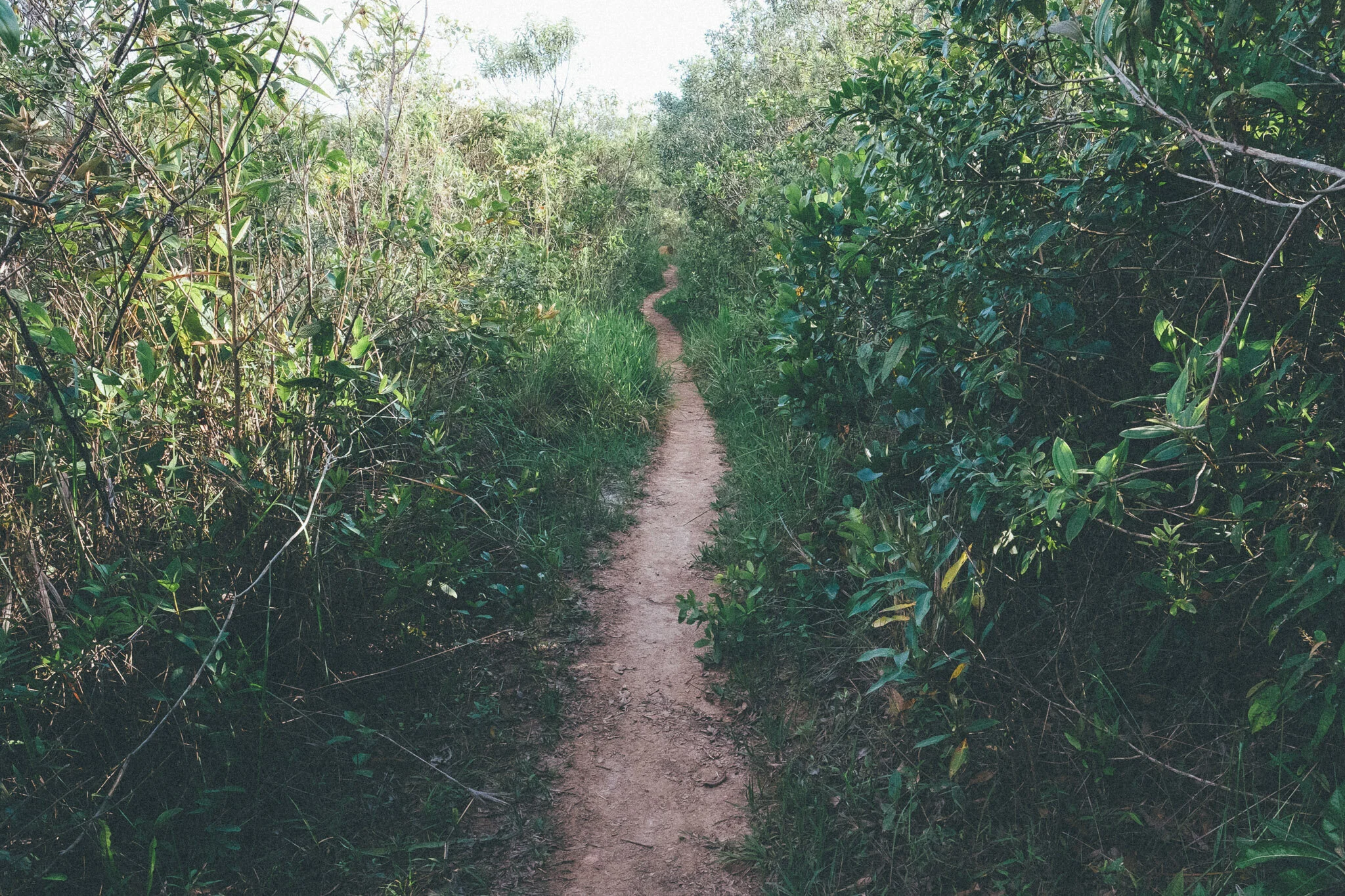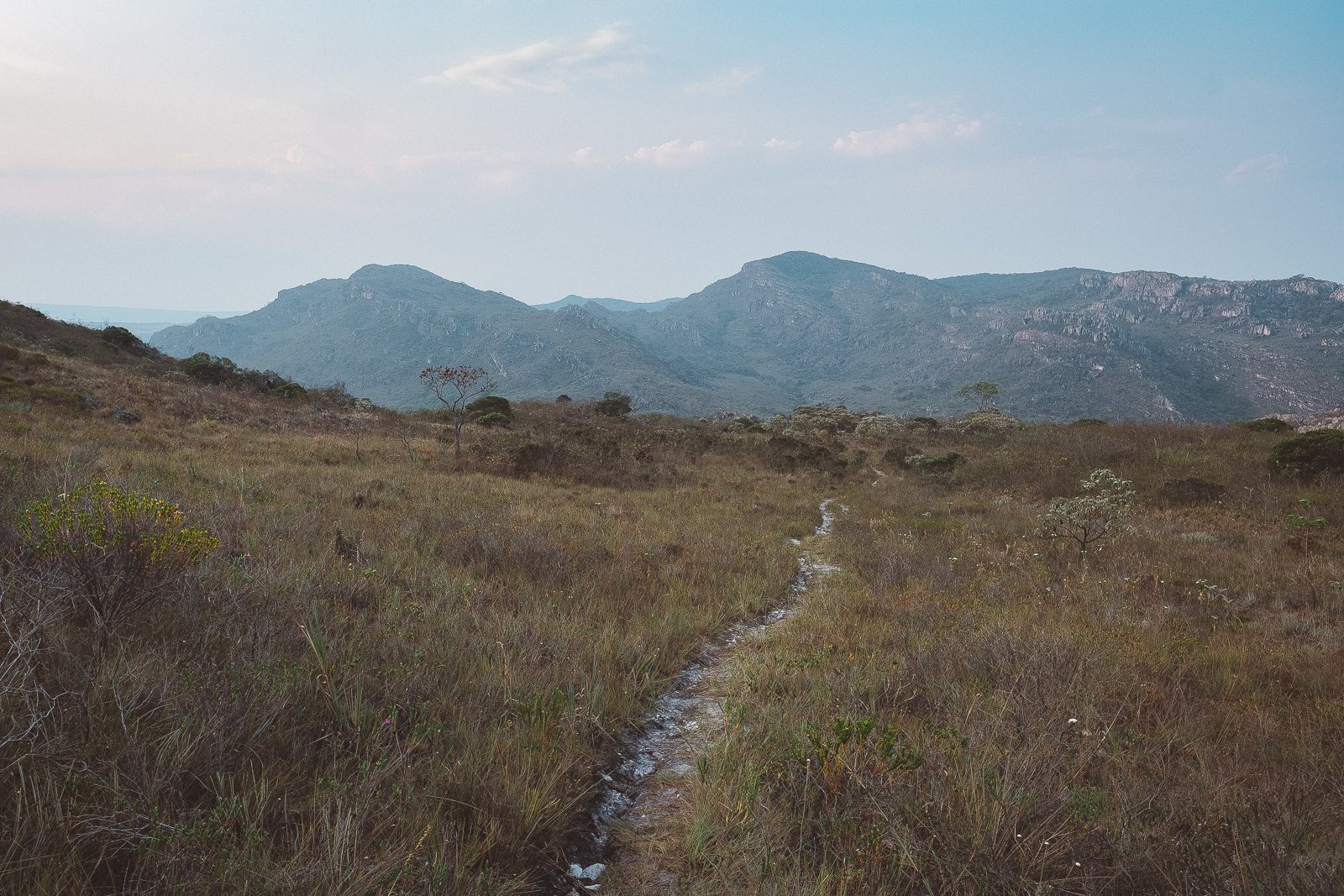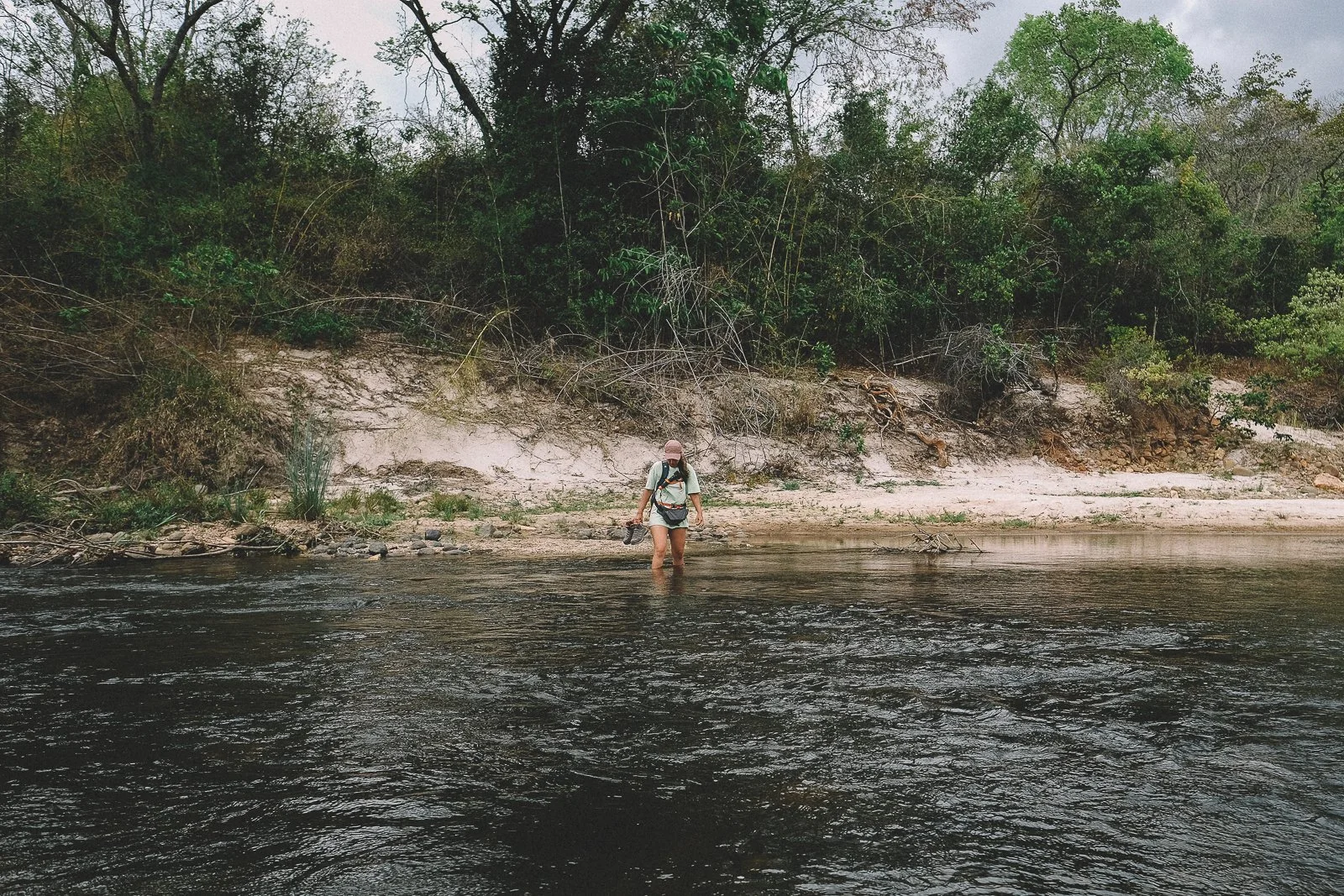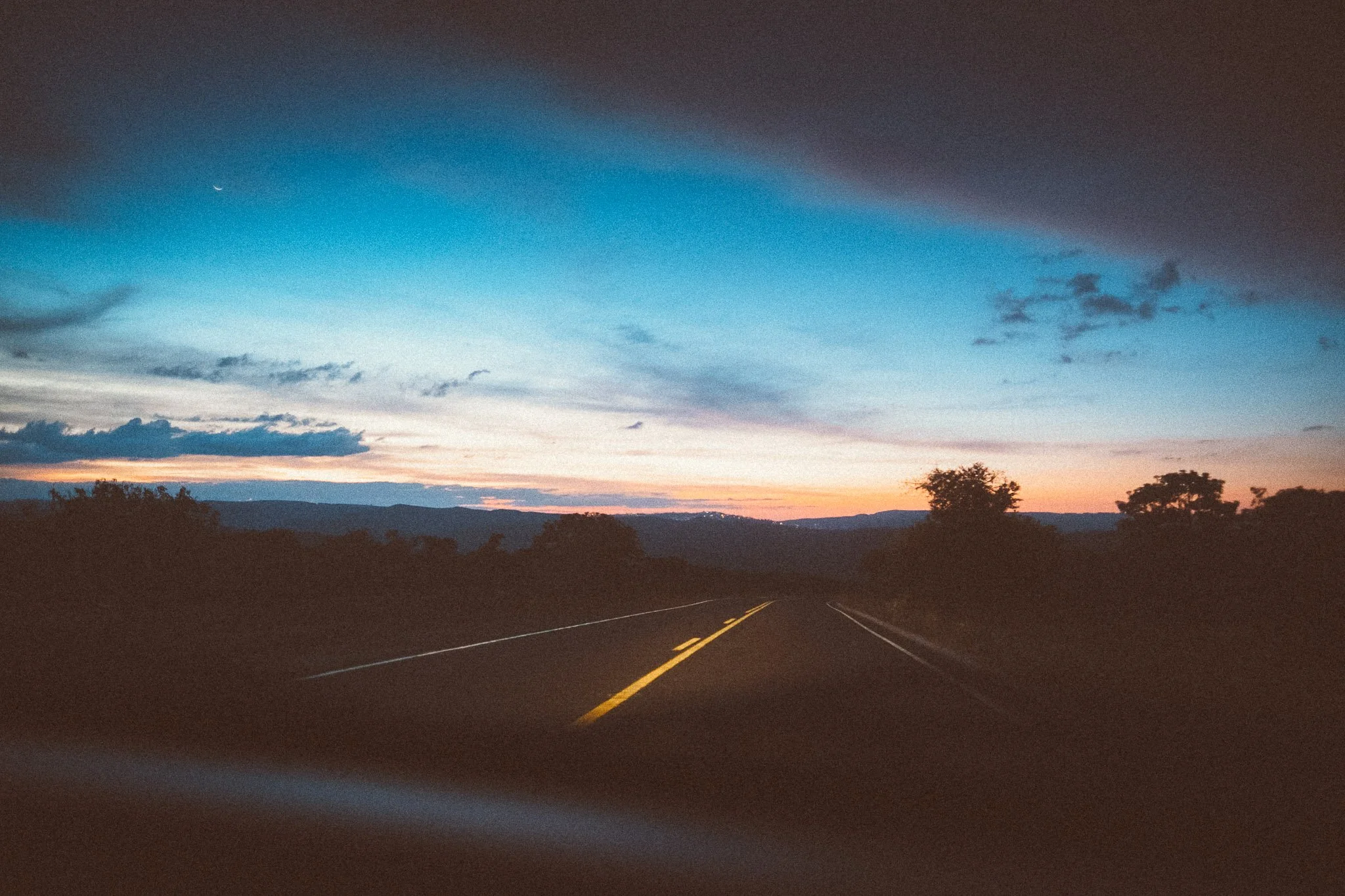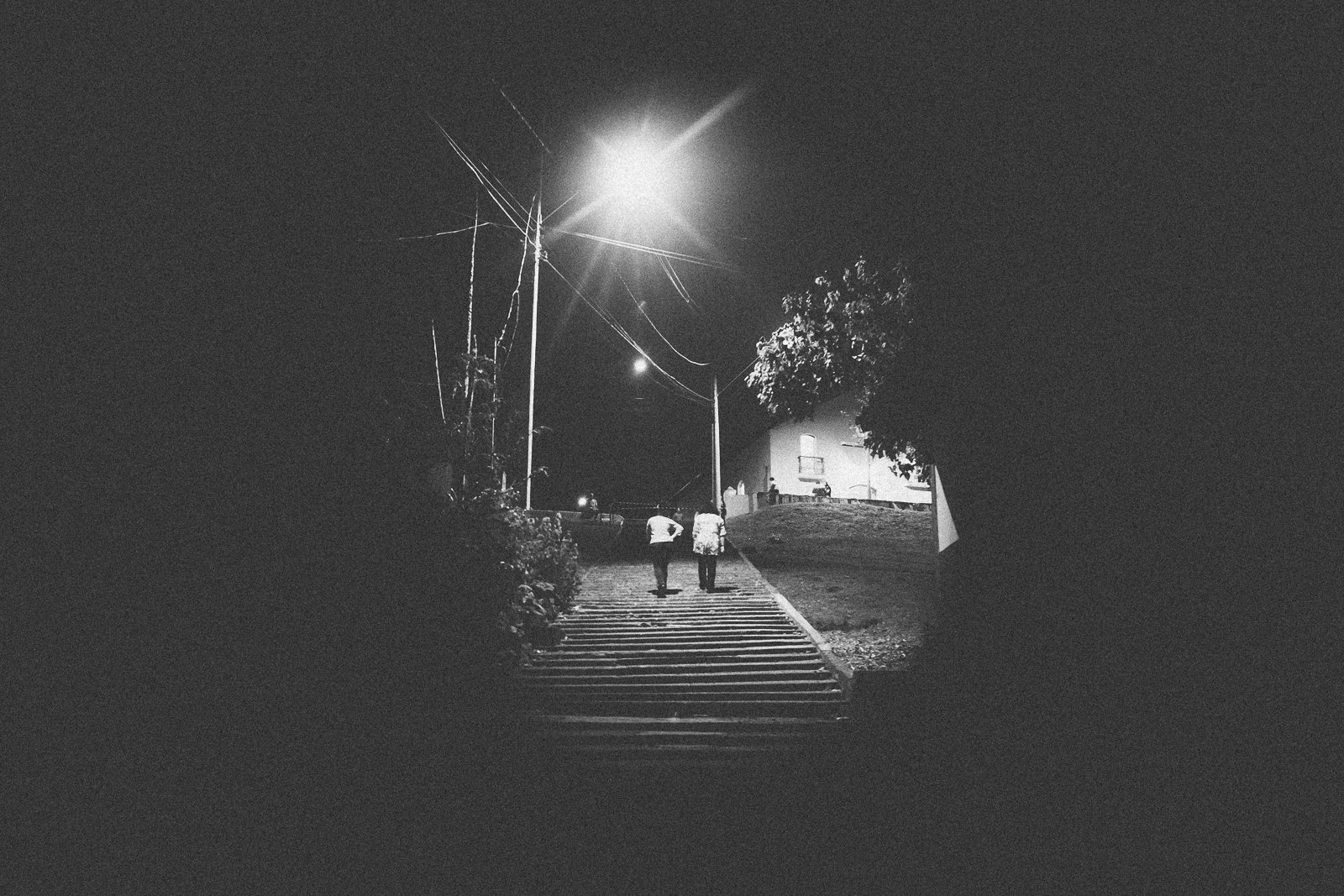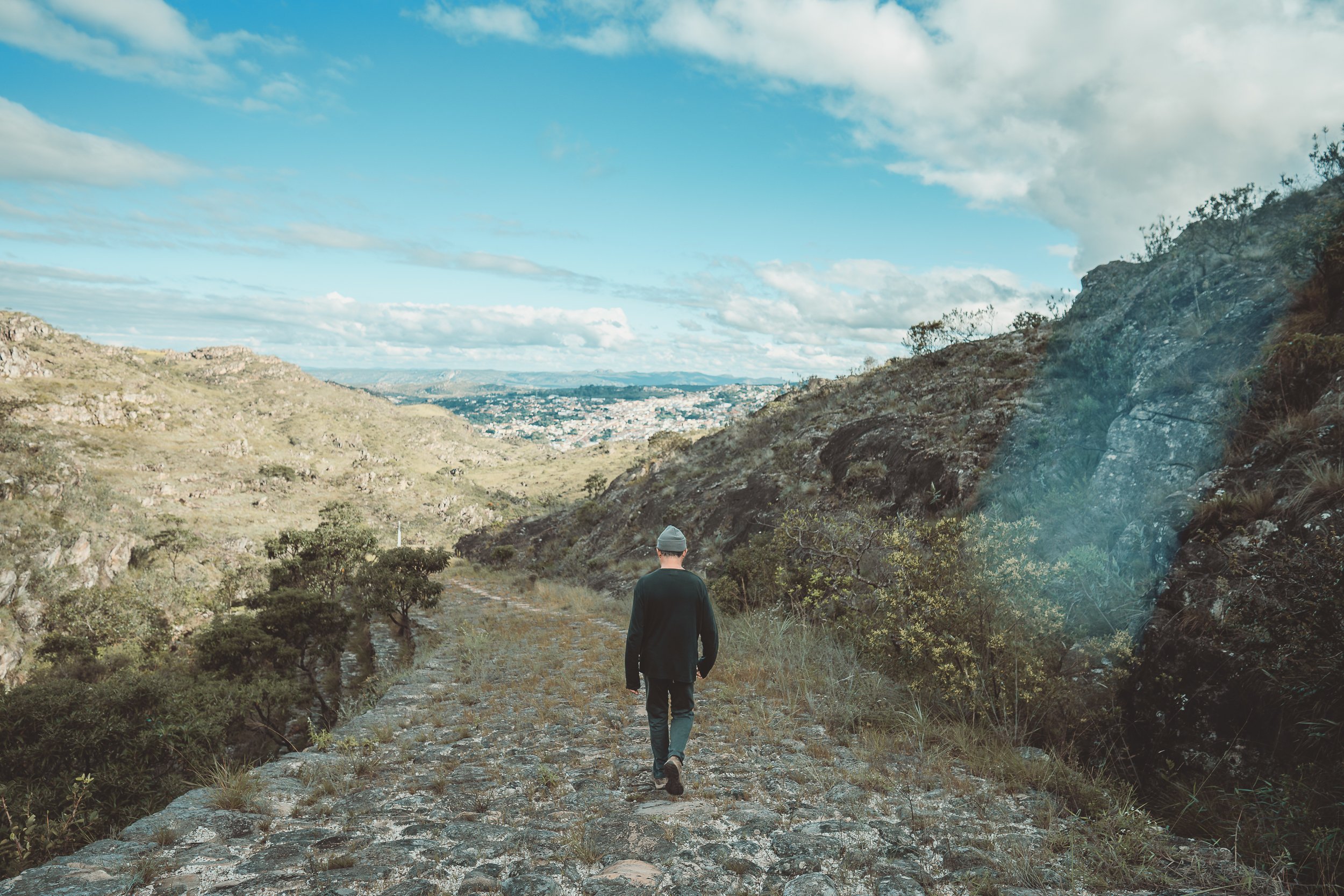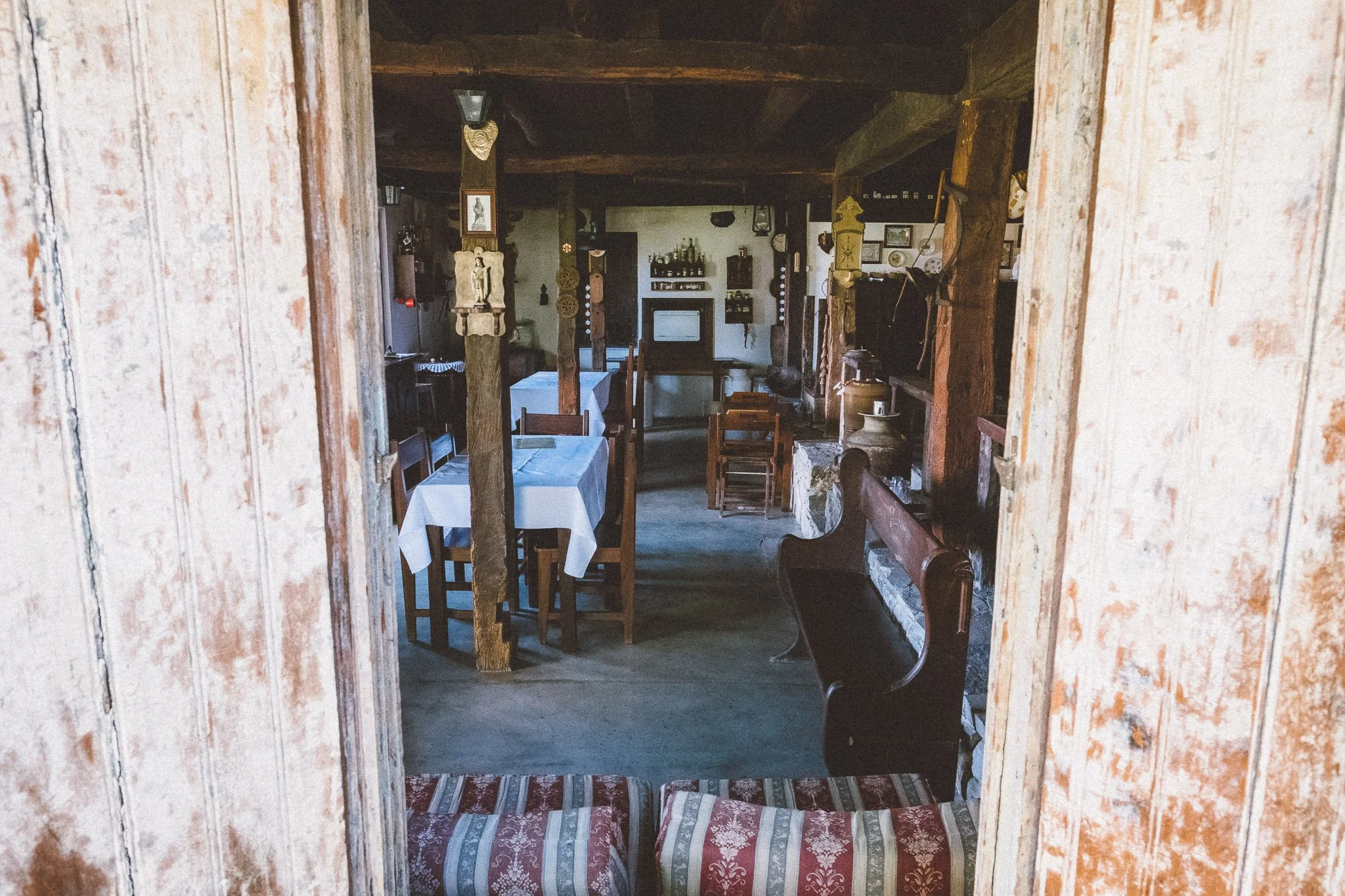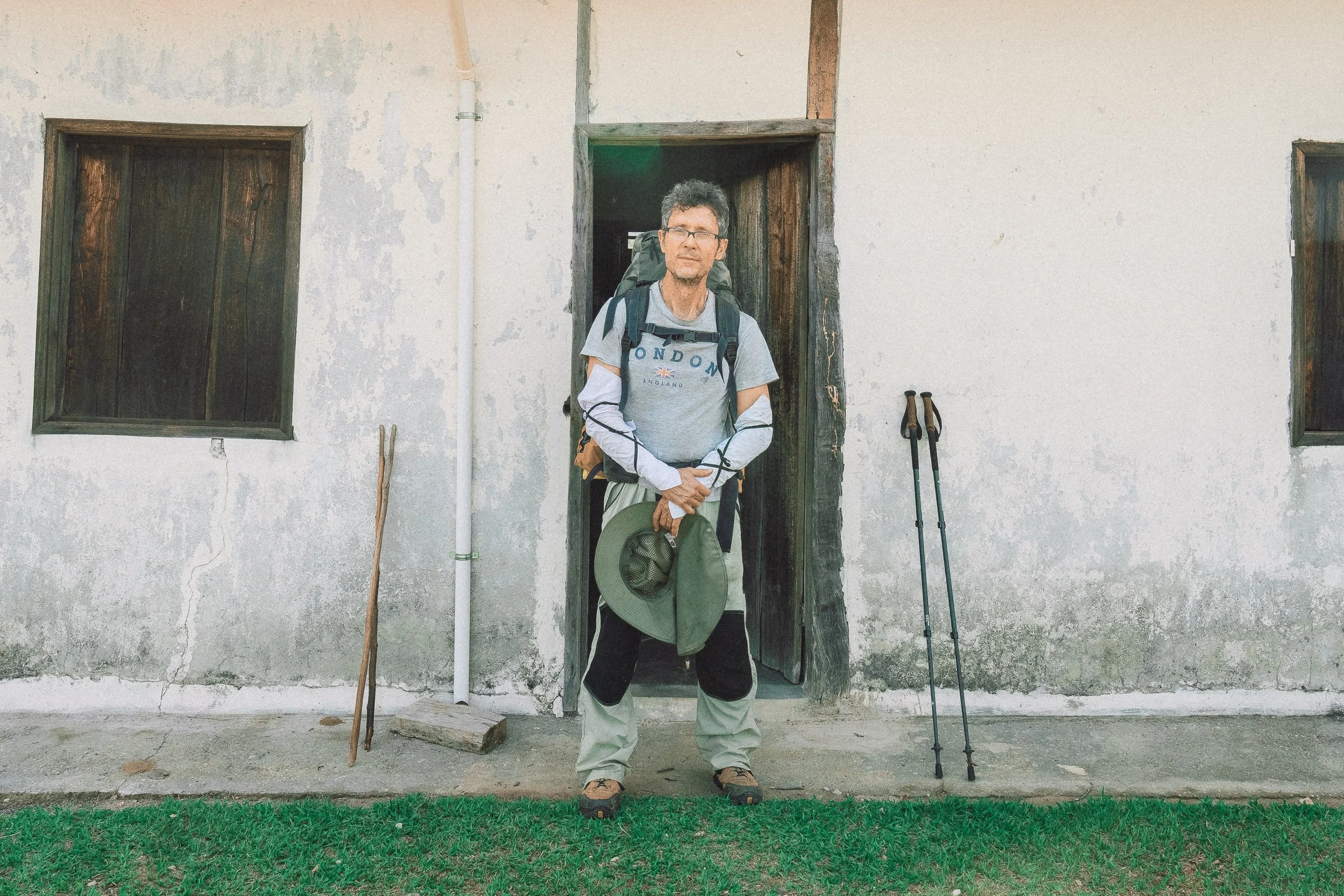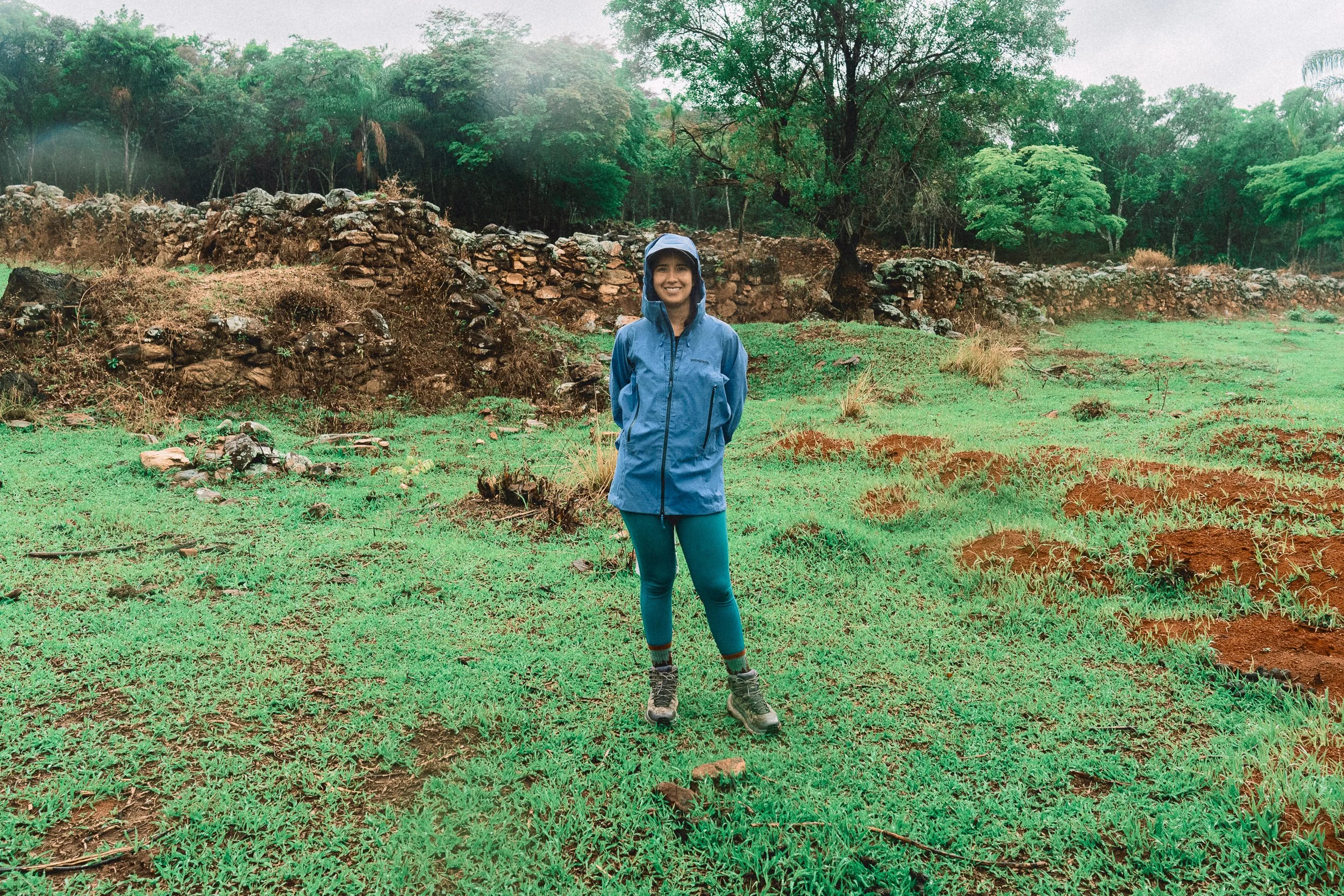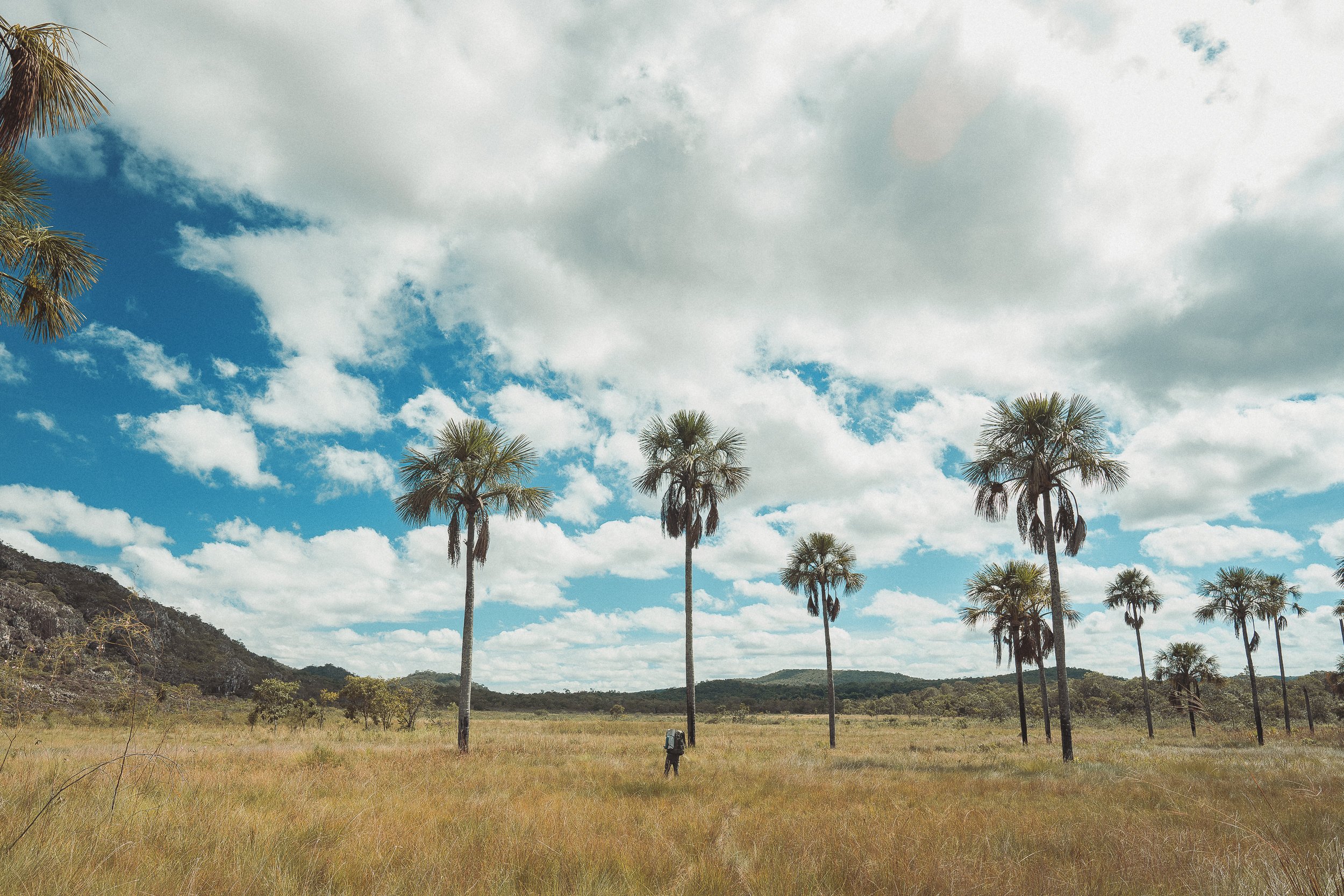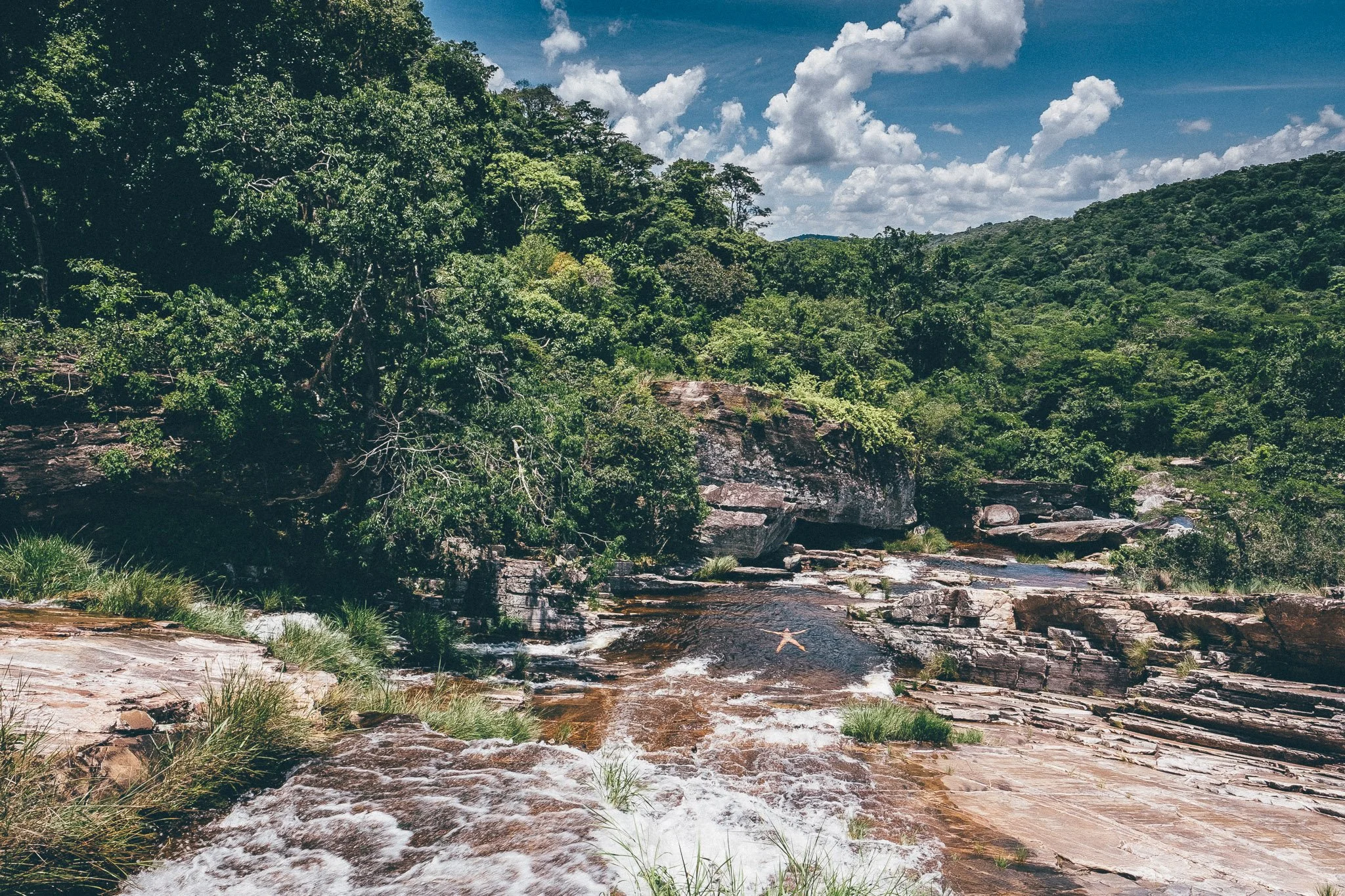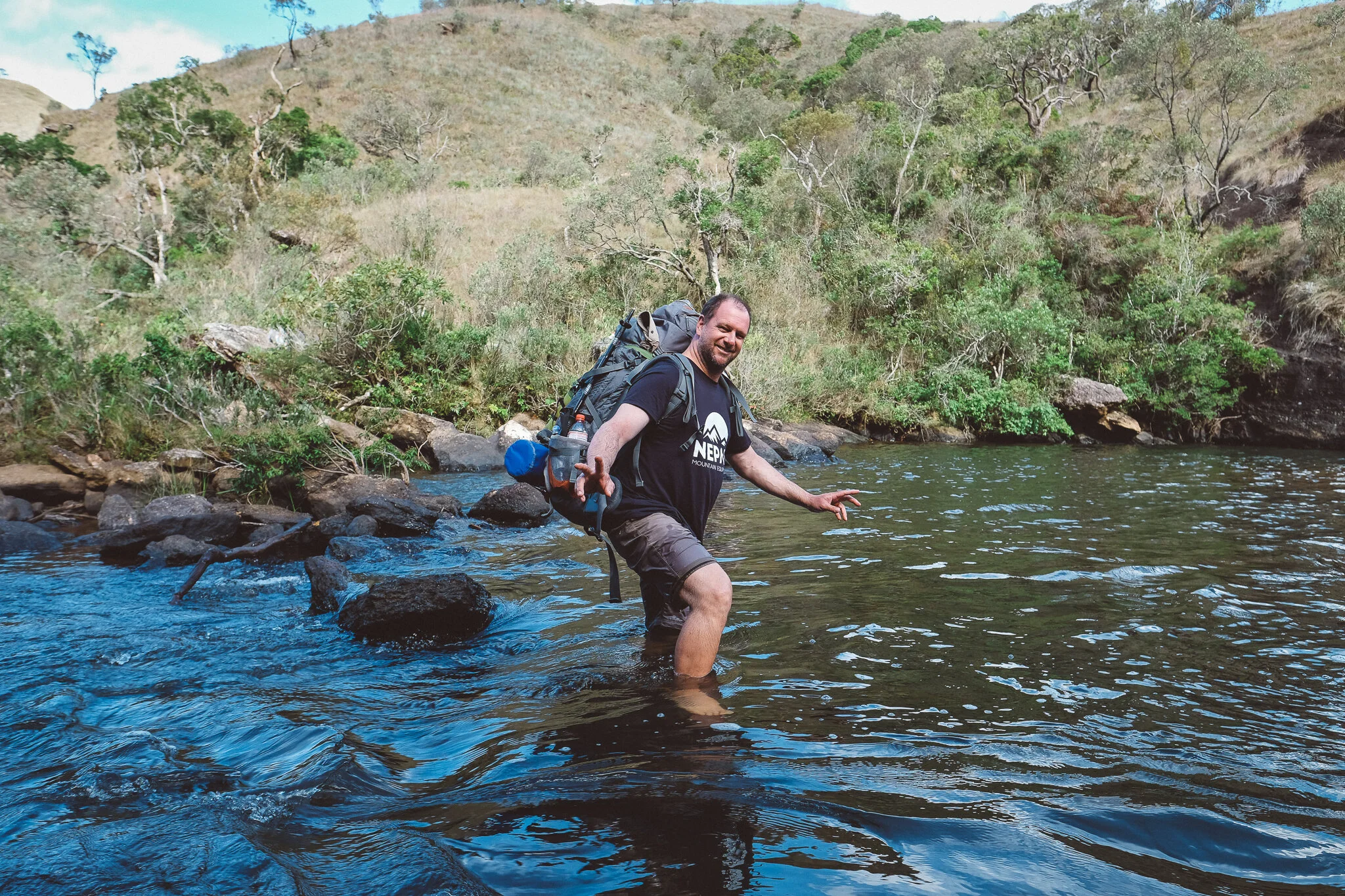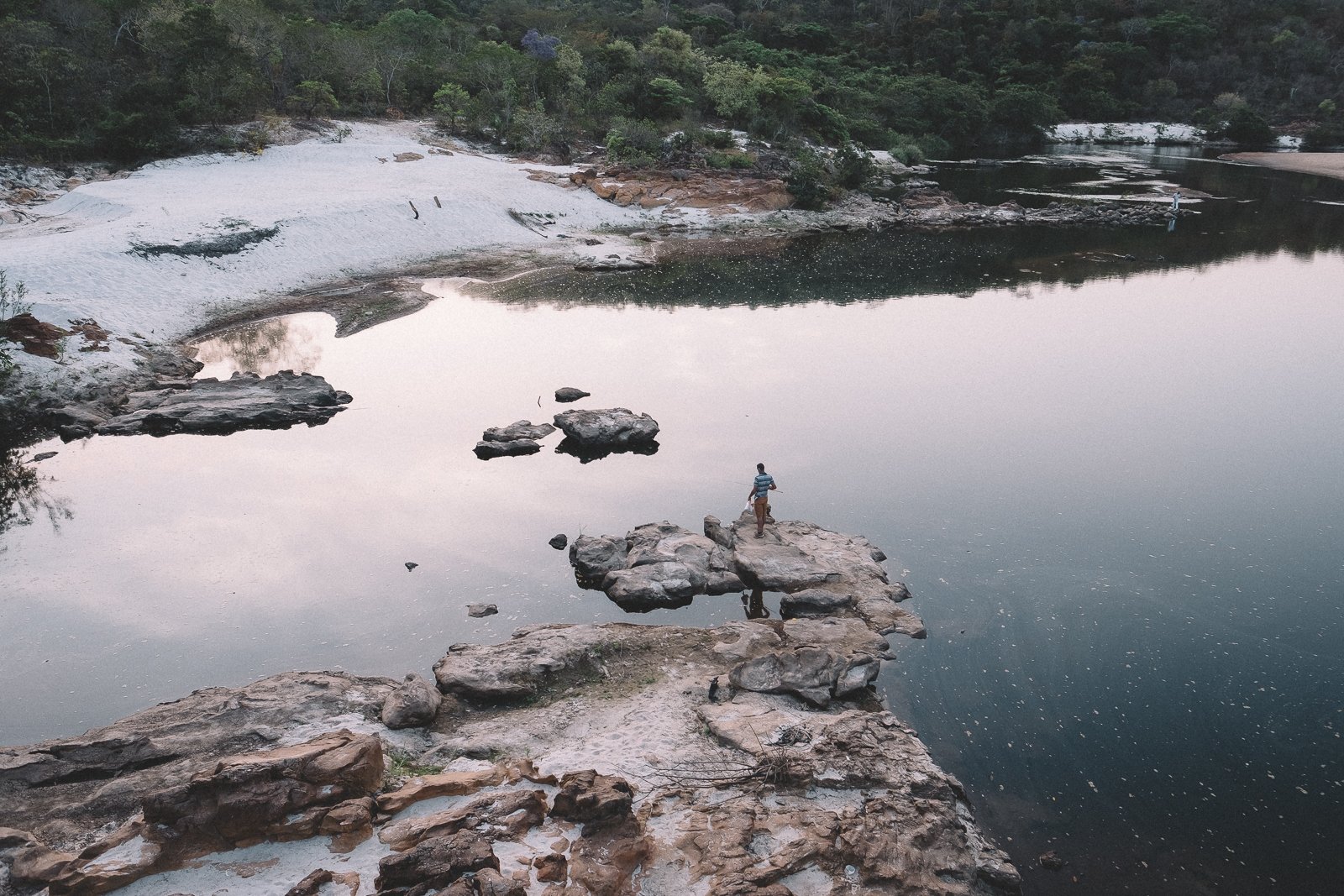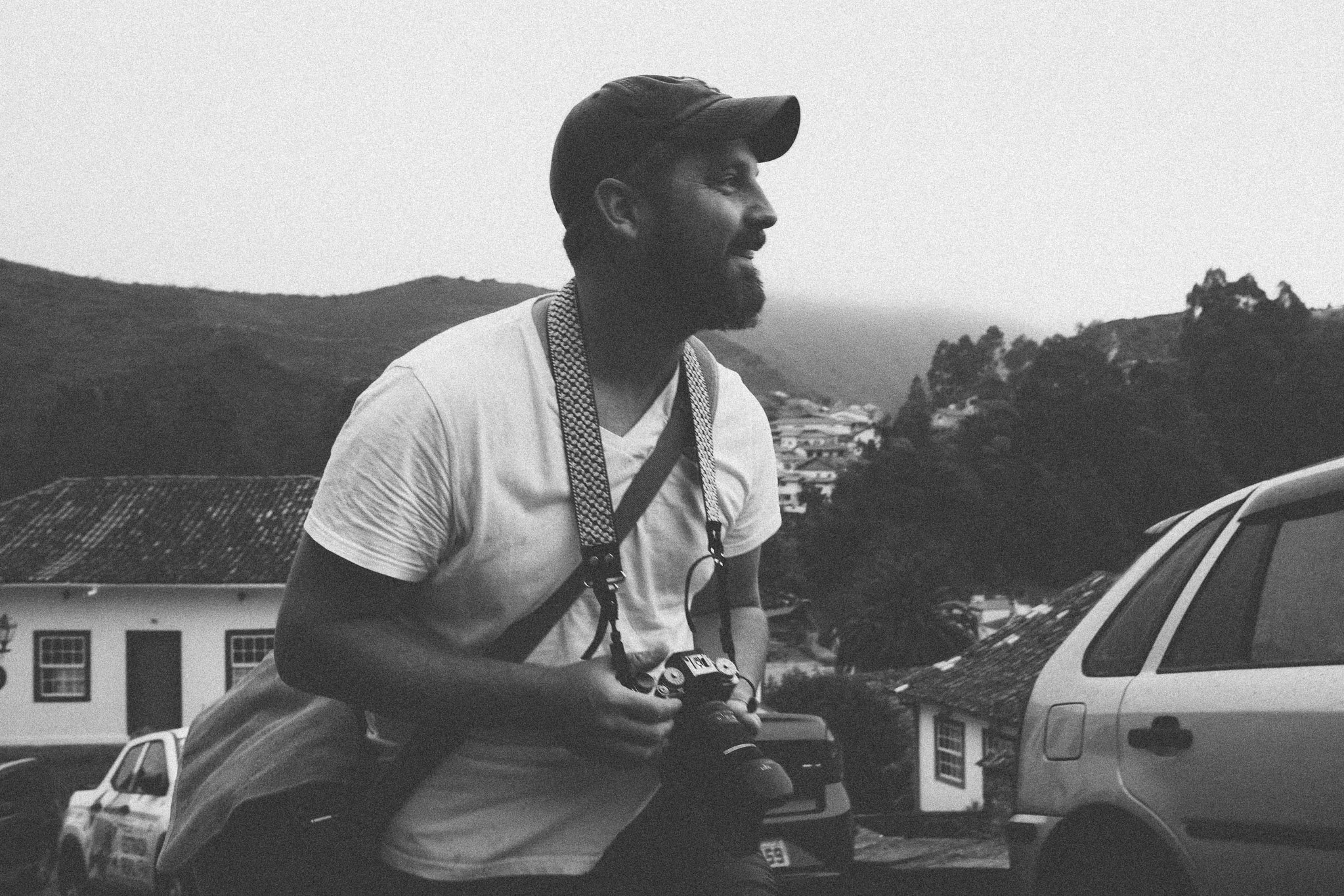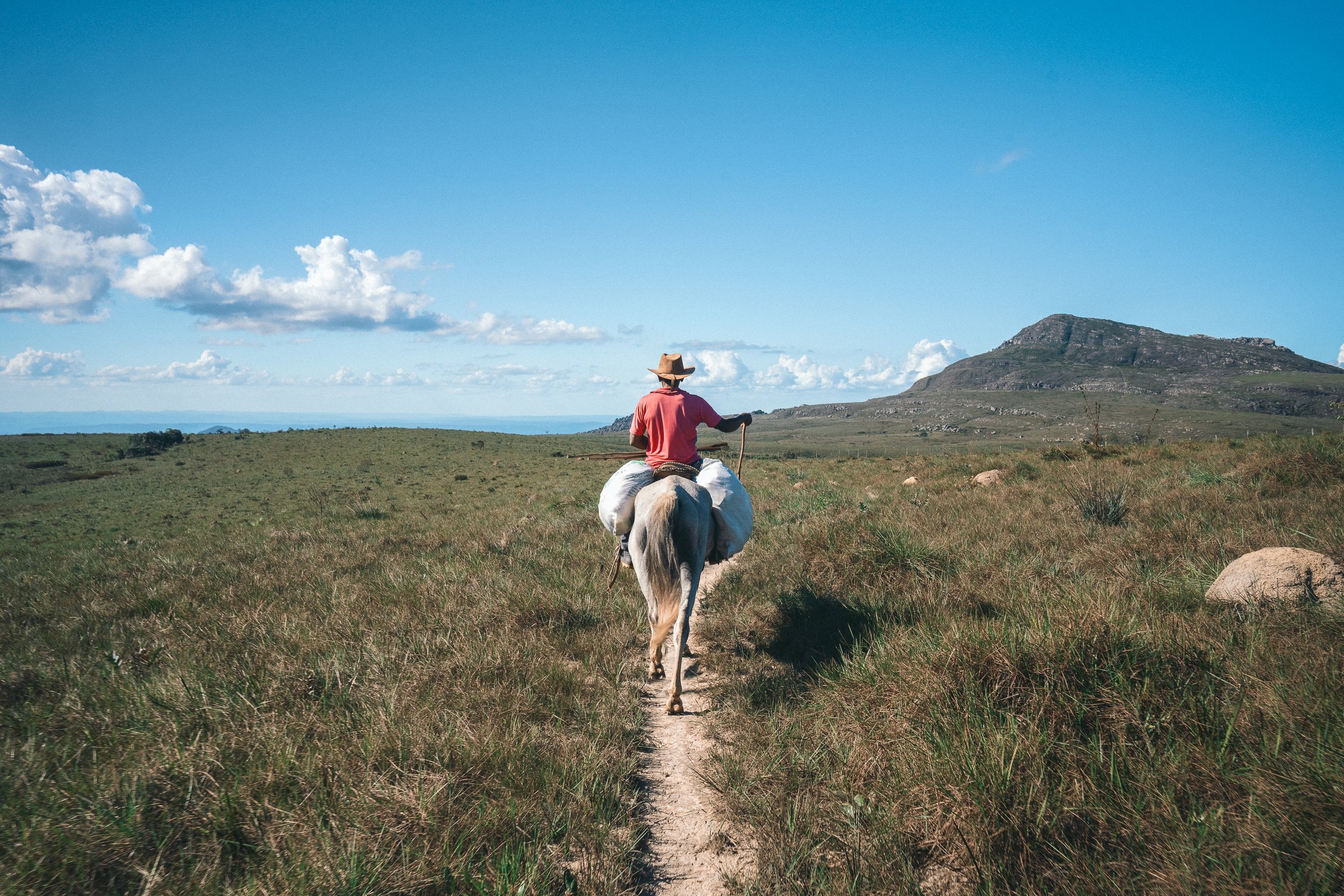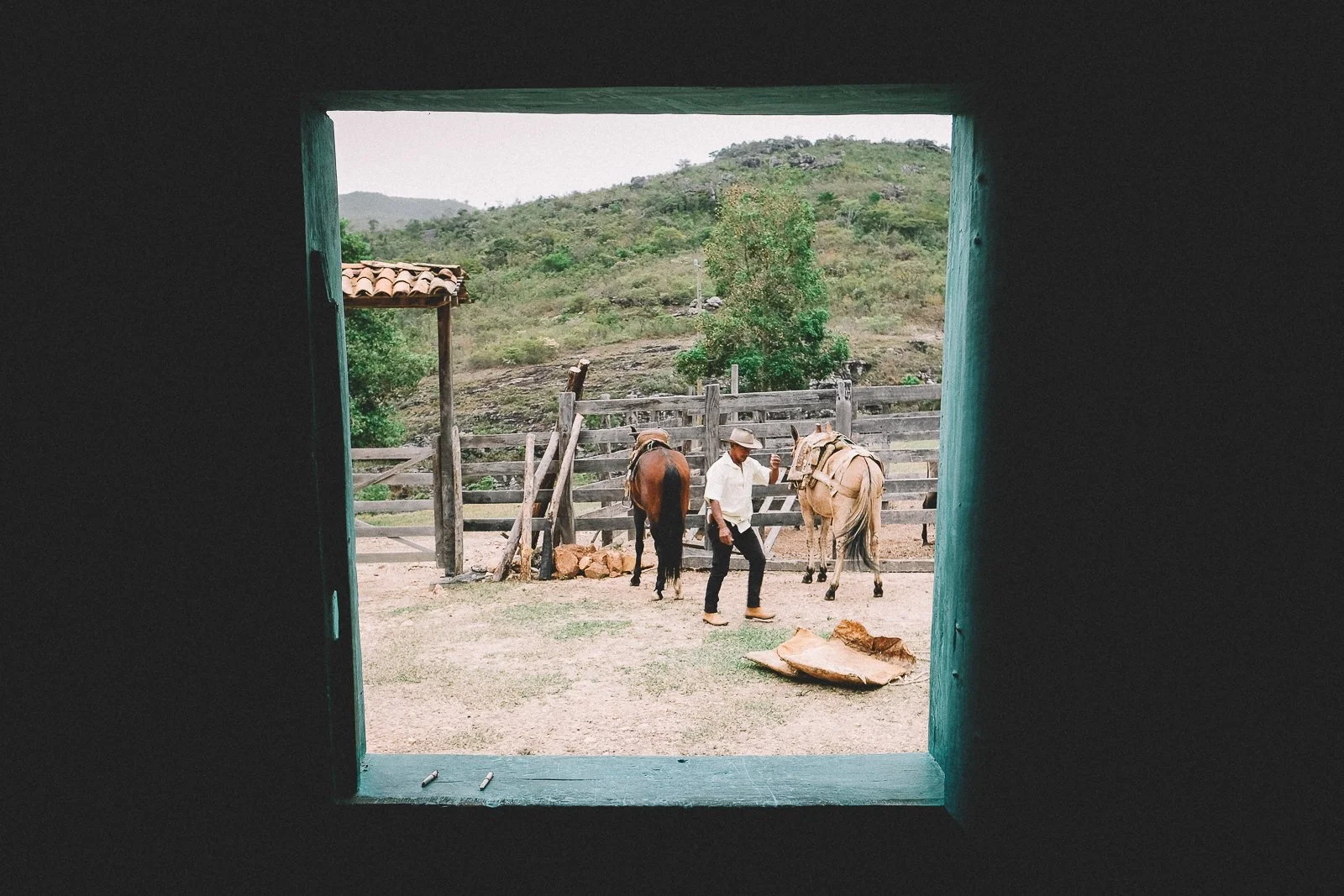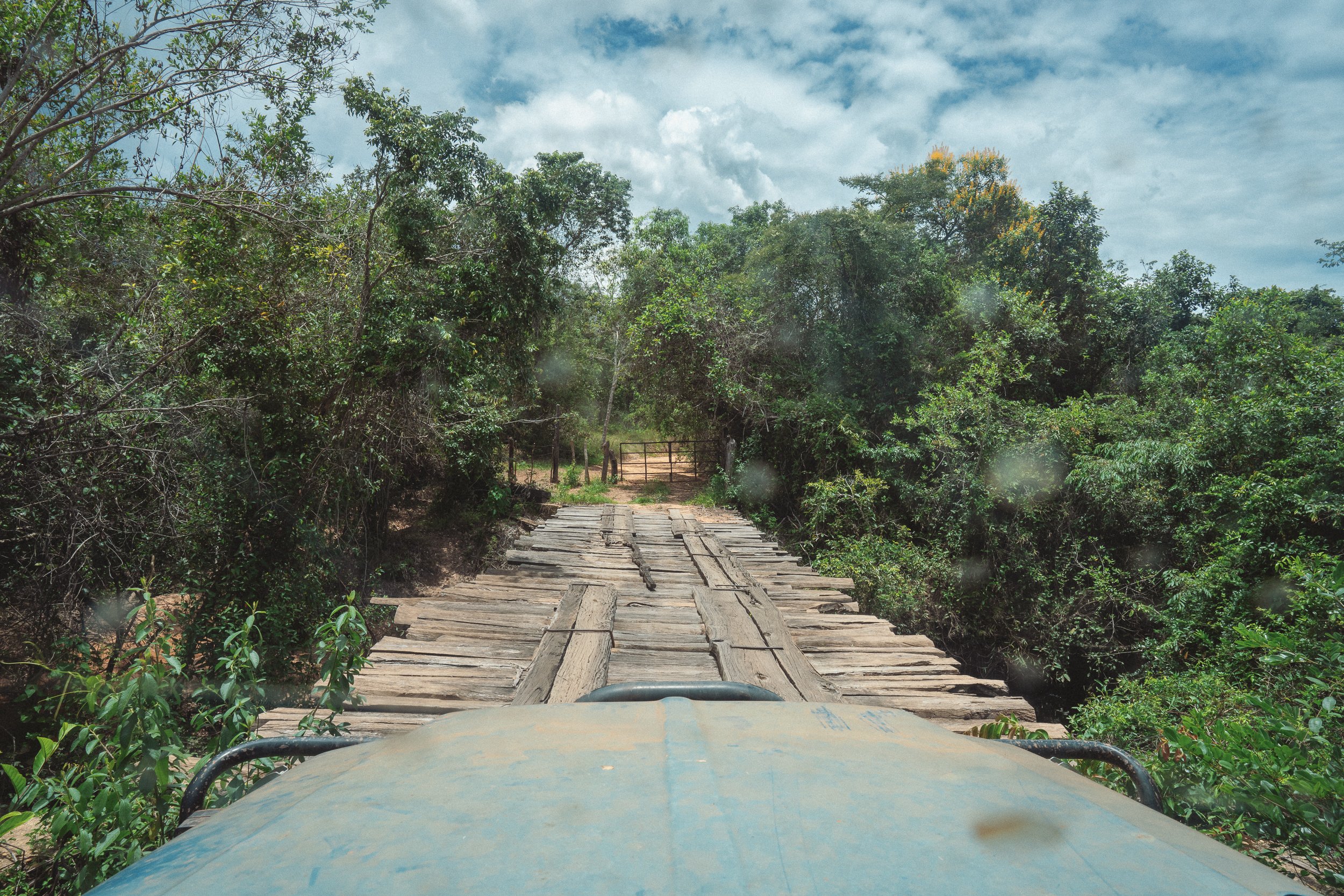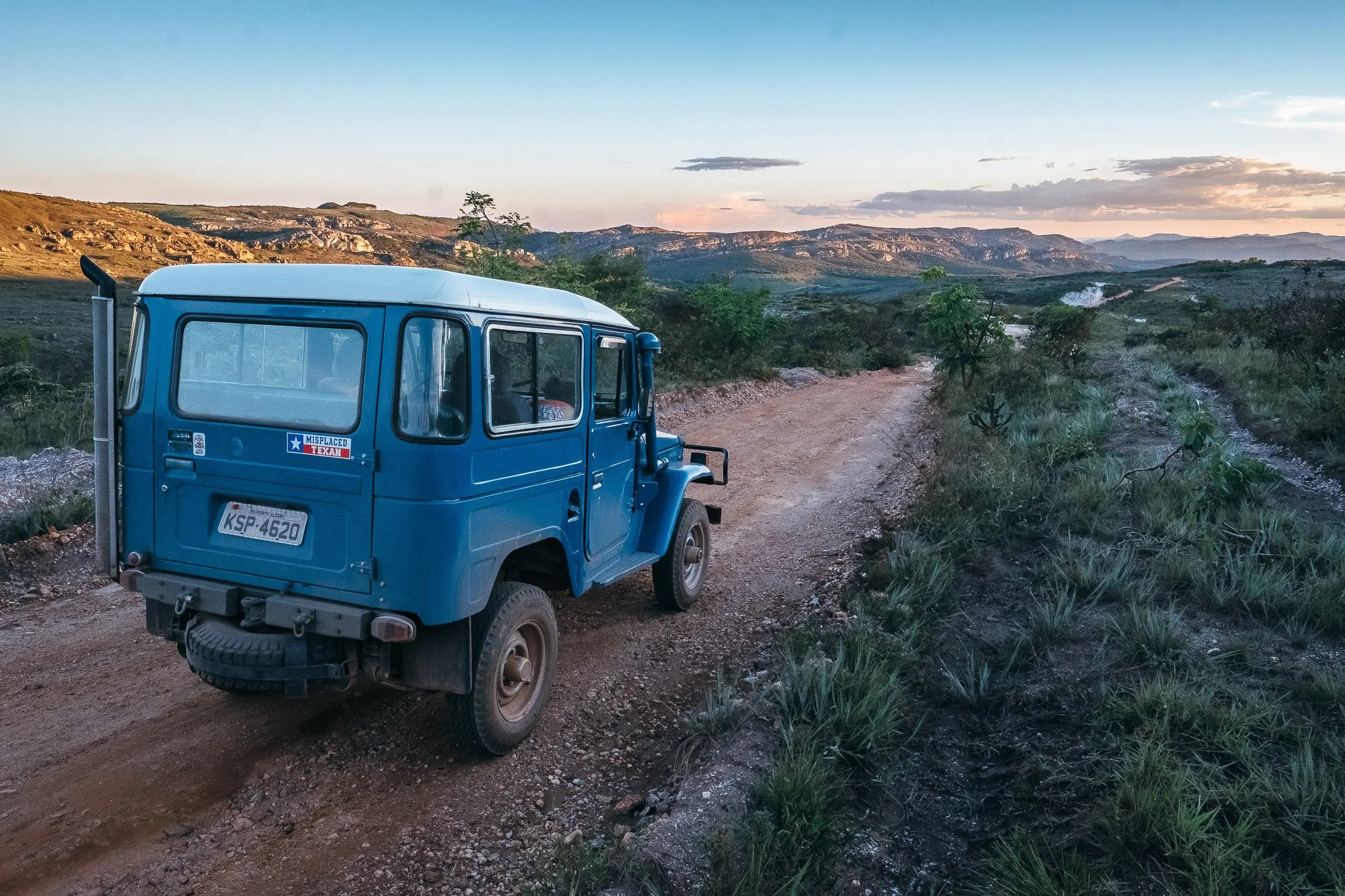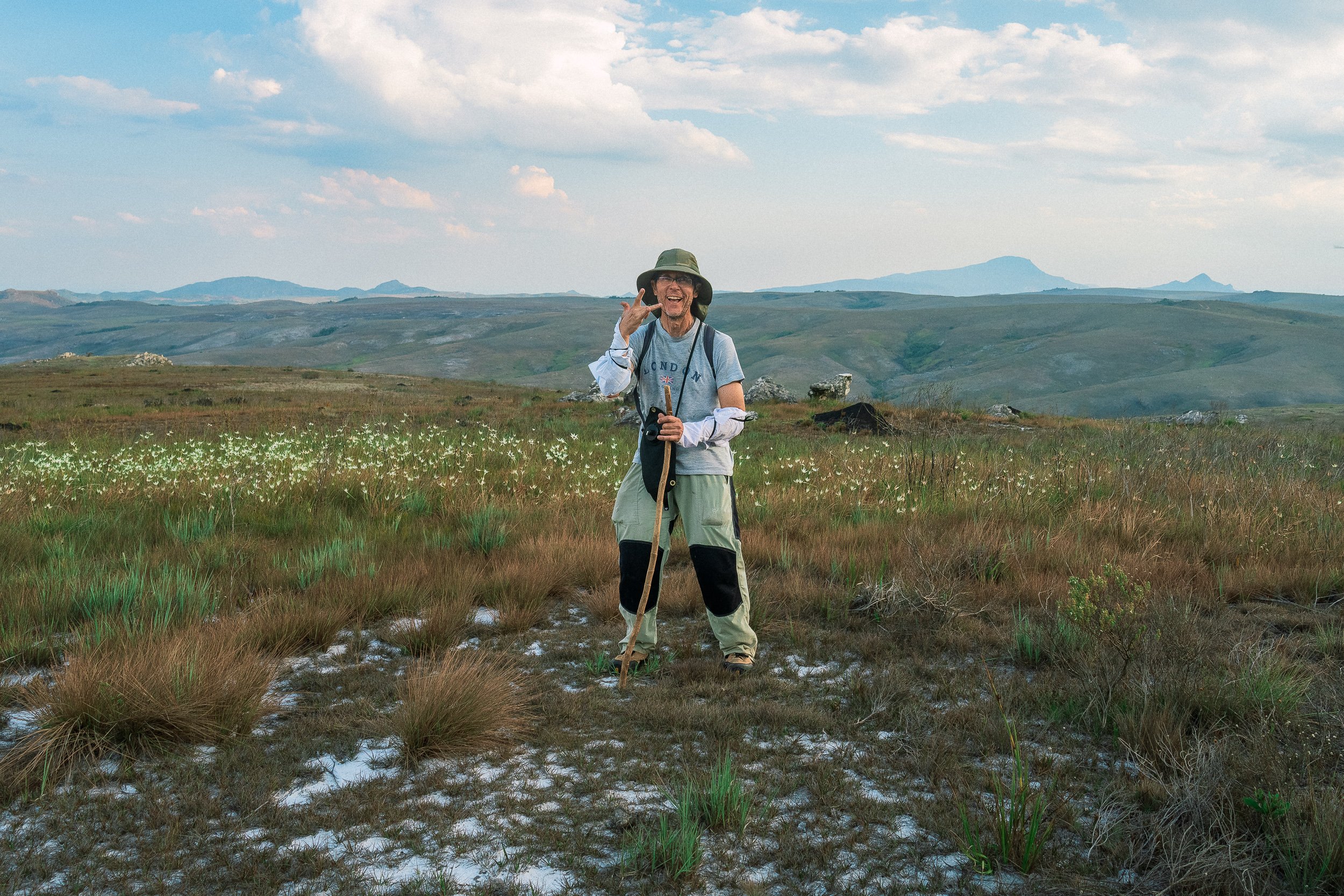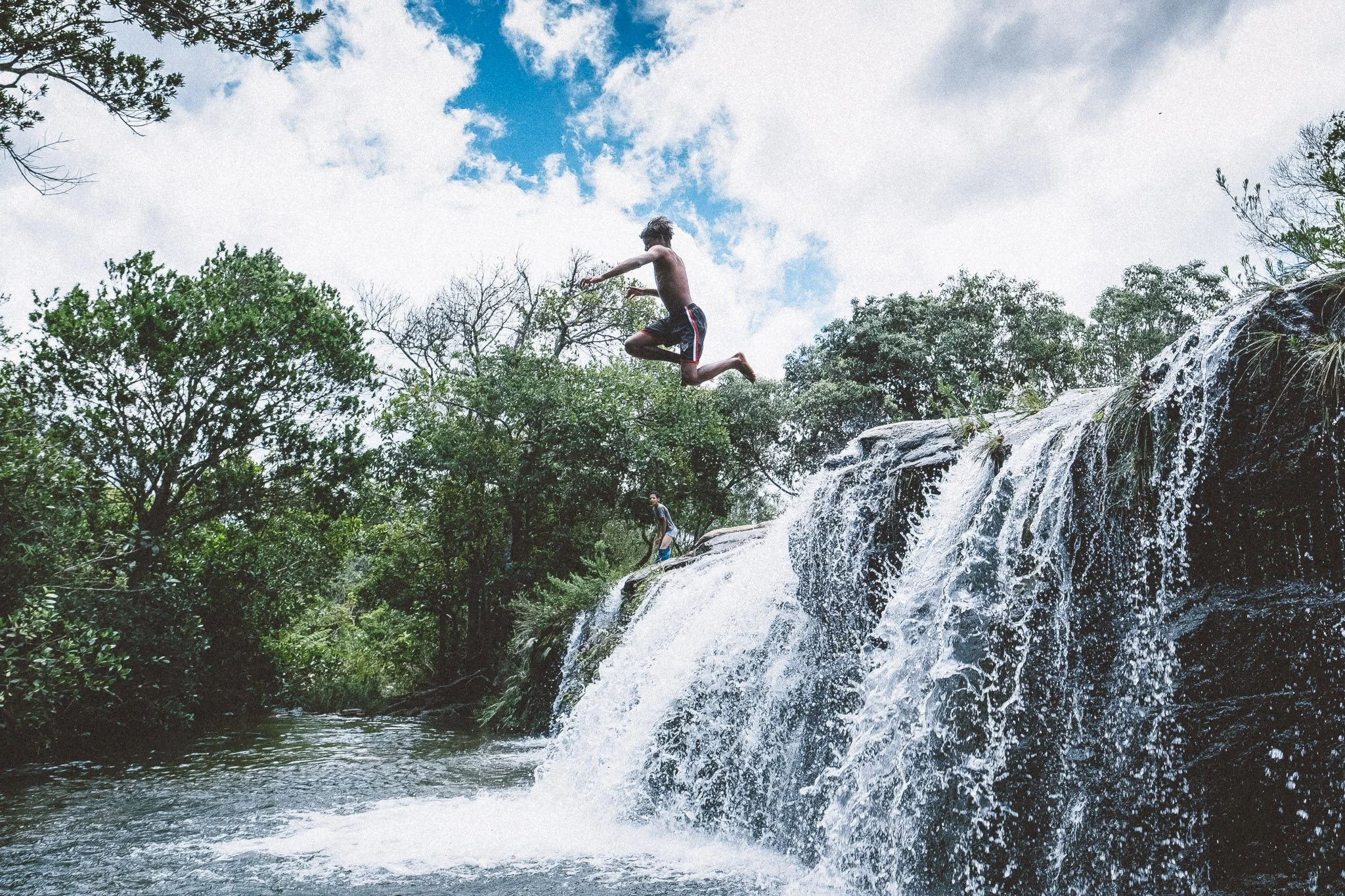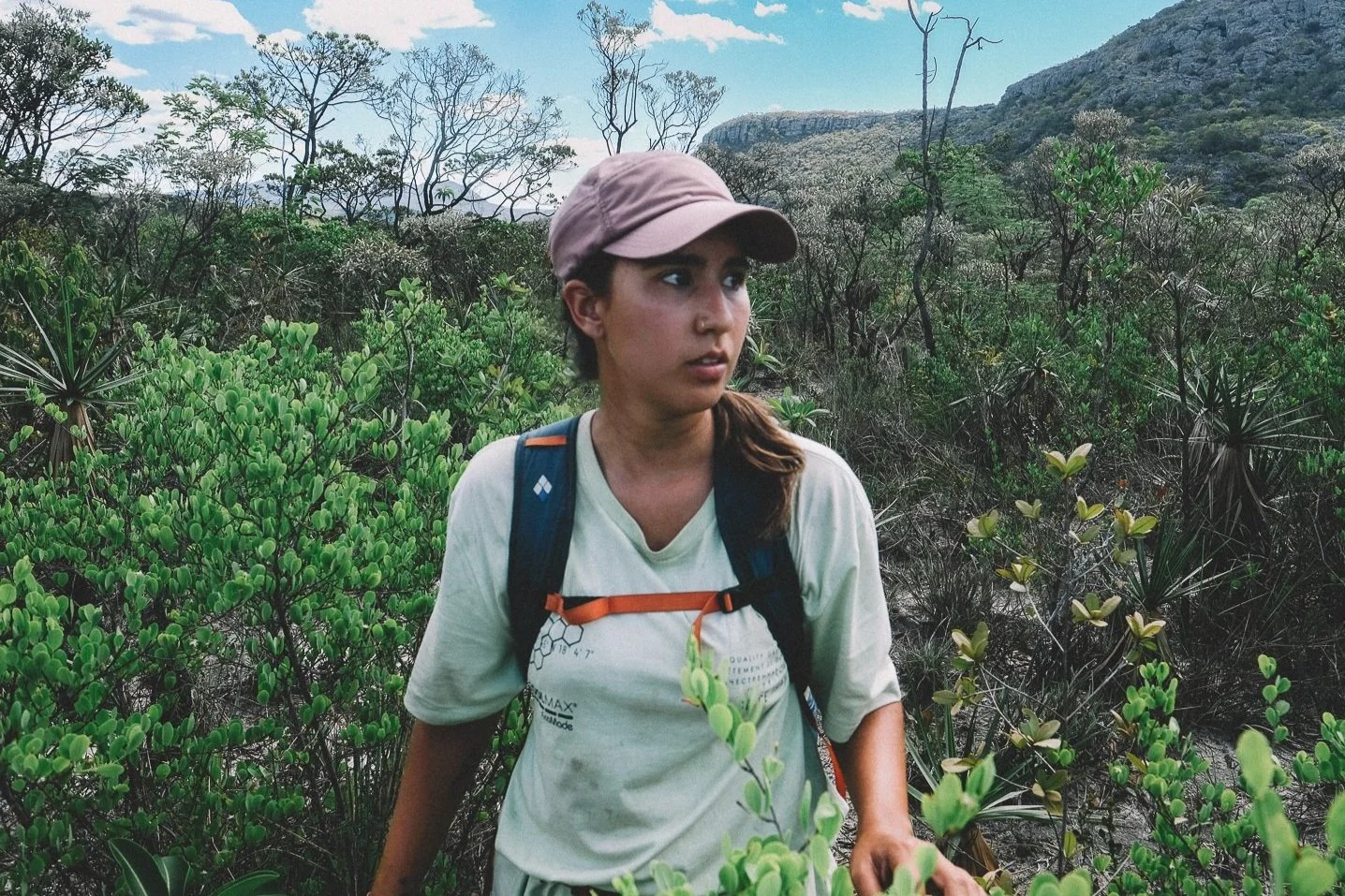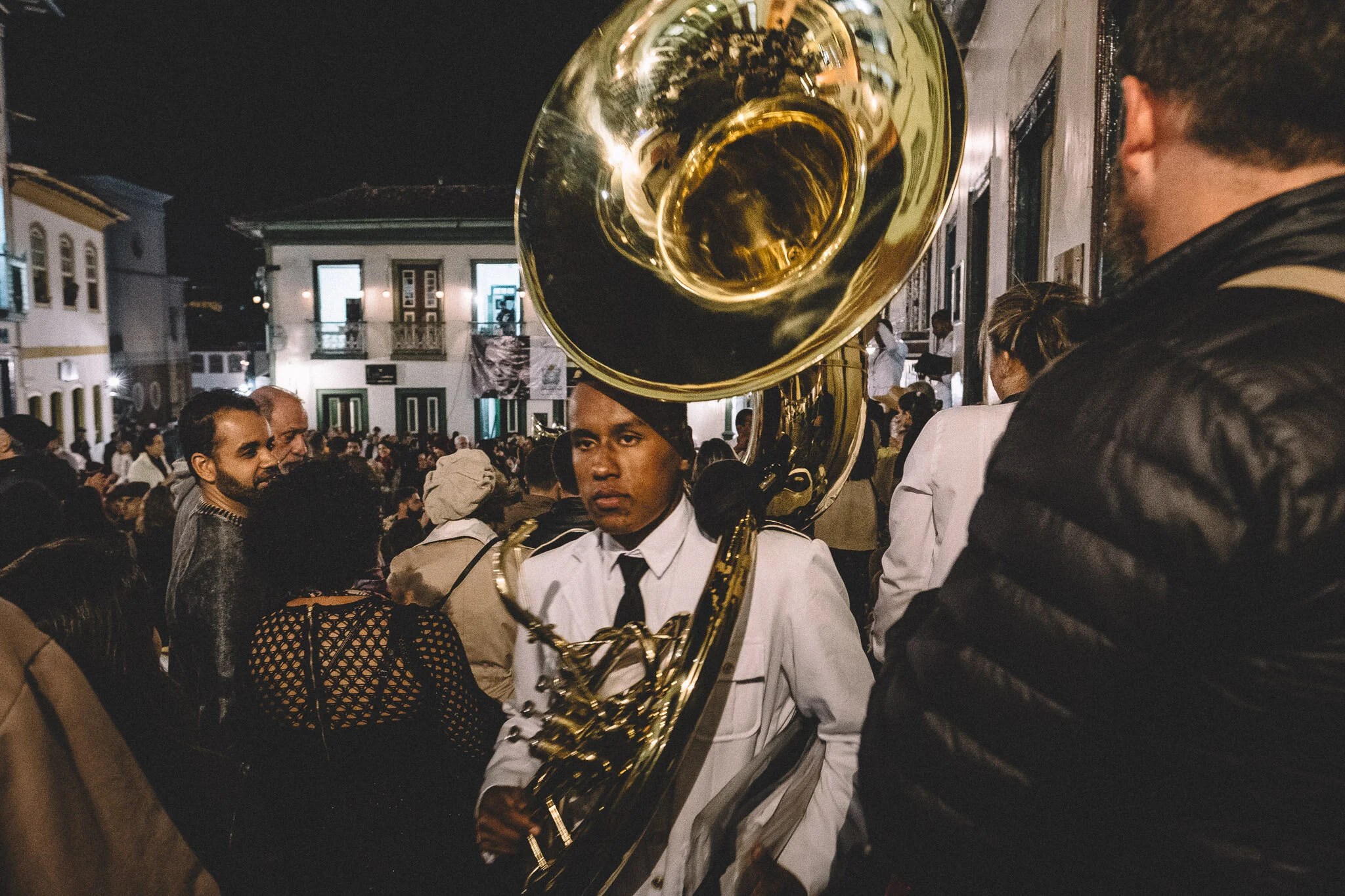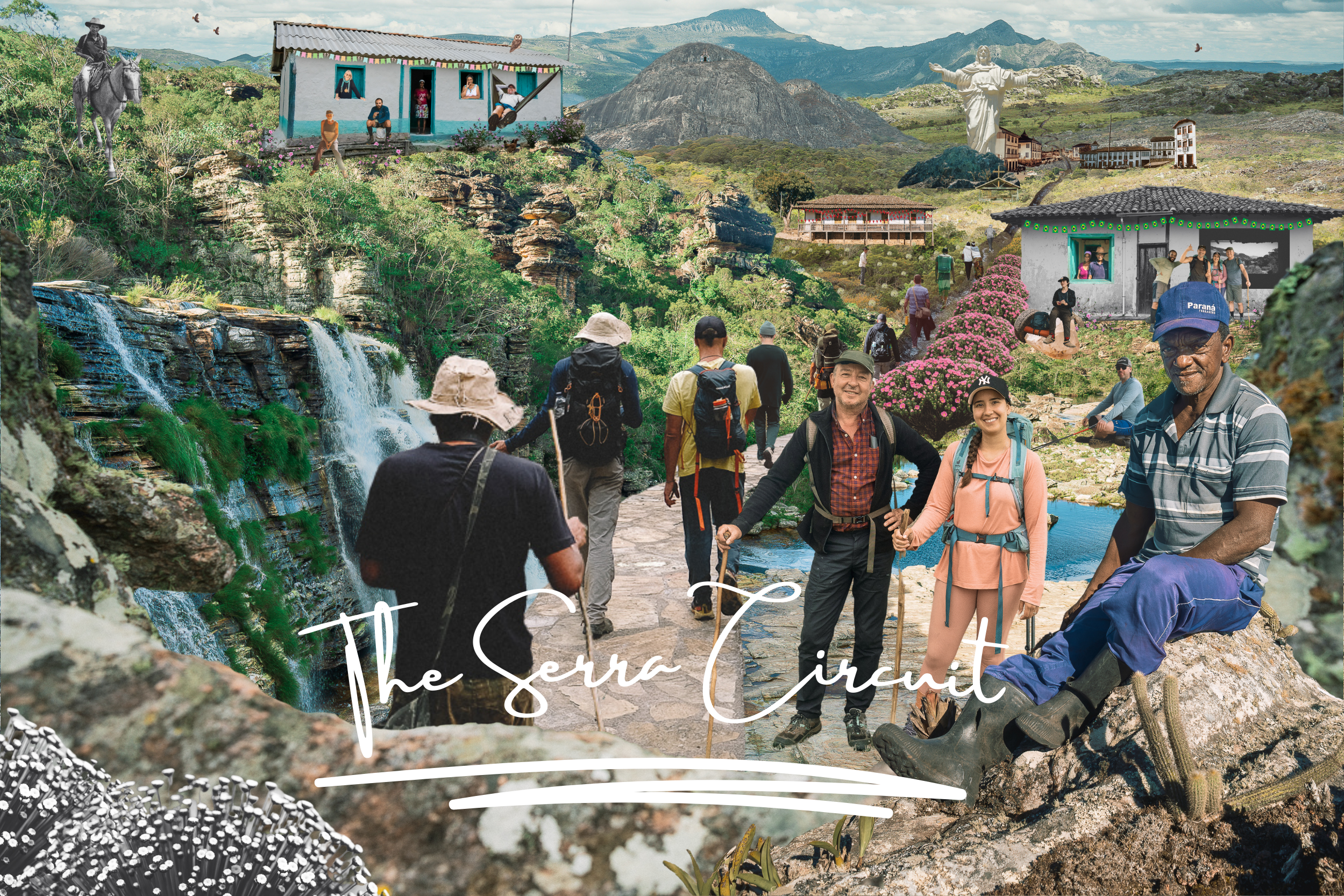
Soaring peaks & white-sand-beach waterfalls.
Centuries-old trails & rivers that ran rich with diamonds.
Mountain towns that still remember.
A story and place time forgot.

At a Glance
A life-affirming trek through Brazil’s forgotten highlands — into a world few outsiders ever see.
-
In short: an immersive, enriching 203-kilometer walk through the peaks, paths & stories of Brazil’s enchanting, unheralded Serra do Espinhaço — a culturally warm, topographically rich, and spiritually grounded region that deserves far more travelers than it gets.
Over the course of 12 days, 4–8 travelers will join our crew on a loop through flower-strewn highlands, white-sand-beach waterfalls, and quiet mountain towns — tracing centuries-old trails across savannah, rainforest, and the Espinhaço’s highest peaks in the process.
We’ll average 22.5 kilometers and 1,433 meters of elevation gain/loss across 10 trail days, with time in the mornings and evenings to let the miles settle and the place sink in. We’ll also be taking full advantage of the region’s cold, clear waterfalls and swimming holes.
The terrain is rugged — but the rhythm is steady, the scenery stunning, and the welcome unwavering.
Each night brings new surroundings — from remote quilombola communities to colonial-era towns, buttoned-up vilas to wilderness shelters tucked deep in the high campos. A pair of evenings in glorious Diamantina bookend the journey — and ease our reentry into the world.
Many travelers will find at least some portions of the trek difficult, but this is not a high-adrenaline expedition. It’s motion-filled, not high-octane. Life-affirming, not ego-testing.
Come for the chance to breathe deeply, walk freely, and immerse completely in a Brazil few outsiders ever see.
Stay for a soul-stirring examination of the Espinhaço we fell in love with — where memory runs deep, the paths still whisper, and the joy of movement is reward enough. -
First and foremost — we’d caution you not to expect any objectively easy days during our 9 days on the trail (not counting our well-earned rest day on Day 8). While some stretches are gentler than others, even seasoned trekkers might call them “moderate—with an asterisk.”
Also worth not expecting:
City tours. Famous landmarks. Souvenir shops. Opulent accommodations (though your definition of “opulent” may shift after a few days on trail). Fancy food (ditto). Wine tastings. All-day connectivity (cell signal will drop often; Wi-Fi is available most mornings and evenings). Television. Complimentary hotel shampoos. Other trekkers on the trail. Any international travelers at all.
-
12 days / 11 nights
-
4 – 8 Travelers, supported by 7 full-time Crew members and a rotating cast of part-time collaborators.
Meet the Crew → -
5/5. It’s a trek — and a challenging one, at that.
Over the course of 10 days on the trail, we’ll cover 203 km and gain/lose 14,327 meters — an average of 22.5 km and 1,433 m of cumulative elevation per day.
Throw in varied mountain terrain, a handful of waist-high water crossings, and some optional horseback riding during our day-long summit of Pico Dois Irmãos on Day 6 — and this is about as active a trip as an experience-hungry, panorama-chasing traveler could hope for.
Insects are a fact of life out here — a small price for moving through one of the most biodiverse and little-touched corners of the Brazilian interior.
Two of our eleven nights will be spent in rustic, unforgettable homestays. One will be spent in a wilderness shelter atop Chapada do Couto — which, while magical, is not exactly known for its mattresses. Comfort comes and goes. Beauty stays.
Prior trekking experience and/or excellent fitness helps — especially in the early going. But in our experience, it’s not the fastest or fittest travelers who thrive on this Expedition. It’s the steady, open-hearted, resilient ones.
-
Cerrado (Brazilian Savannah) & Mata Atlântica (Atlantic Rainforest)
This Expedition unfolds across one of the richest — and rarest — ecological transition zones in Brazil. The eastern stretch of the Espinhaço Meridional, where we’ll spend our first 8 days, marks a striking overlap between the Cerrado and the Atlantic Rainforest — two of the most threatened biomes on earth, each with its own distinct rhythms, textures, and species.
From Days 9 to 12, the landscape opens wider into the high campos of the Cerrado proper: a rolling mosaic of savannah ecosystems, from riparian forests to rocky rupestrian fields. It’s a biome of subtle drama — and startling resilience.
-
May 20 - May 31, 2026
[Contact us →] or [Hold my place →]
-
Adventurous, open-hearted travelers seeking one of the most rewarding, immersive treks in South America.
You don’t need to be a seasoned trekker or a world-class athlete to complete this 10-day circuit (with overland transfers on Days 1 and 12). We’ve done similar routes alongside first-time trekkers — including teenagers — who thrived. The key is resilience, curiosity, and a steady pace.
What you do need: the ability to walk 22.5 km per day for 10 days, a spirit of camaraderie, and a genuine interest in exploring this little-known corner of Brazil — with all its natural beauty, quiet hospitality, and cultural depth.
If that sounds like you, we think you’ll love it.
Note: Due to the remote nature of this trip, we do not recommend it for first-time international travelers, and we do not accept solo applicants under the age of 25. A signed Bill of Good Health from your provider is required as part of your application.
Think this might be your kind of trip?
We’re here if you want to talk it through — or just want to learn more.
Peaks, Prosa, and the Trail Between
21 tales that light the path →
Itinerary
12 days of mountains, miles & meaning →
Still here? We’re here if you have questions.
If you’d like the full day-by-day itinerary — the one with spoilers — just say the word.
We’ll be happy to send it your way.

A Range With Stories to Tell
Once the epicenter of the global diamond trade, Brazil’s Serra do Espinhaço Meridional (the geomorphological name for the rocky mountains surrounding Diamantina, in the state of Minas Gerais) was abandoned and largely forgotten by the outside world for nearly two centuries.
Today, it’s on the cusp of being recognized as one of the most spectacular places on earth.
3 UNESCO Designations
2 Biodiversity Hotspots
19 Conservation Units
3,000+ species of plants (estimated)
7% of Brazil’s total biodiversity*
0.8% of Brazil’s national territory
* Brazil is the most biodiverse country on earth
The Path Ahead
Total Days: 12
Trekking Days: 9–10*
Riding / Pack Animal Days: 0–1*
Transfer Days: 2
Trail Distance: 203 km
Transfer Distance: 560 km
Average Trail Distance / Day: 22.5 km
Cumulative Elevation Gain / Loss / Total:
7,009 m / 7,318 m / 14,327 m
Average Elevation Gain / Loss / Total / Day:
701 m / 732 m / 1,433 m
*Travelers will have the option of trekking or riding on Day 6. Pack mules will also be available to carry gear on this day.
Where We Sleep →

WHat We Eat
Tropeiro. Torresmo. Frango com quiabo. If you’re unfamiliar with comida mineira, you will be by the end of the trip—and Brazilians everywhere will be jealous. From piping hot, highly caloric homemade meals—prepared by skilled hands & well-seasoned cast-iron pots over wood-fired stoves—to sophisticated offerings in Diamantina, well, let’s just say we rarely meet our weight-loss goals during trips. It’s worth it. Bom apetit!
Crew →
Questions? We’re here whenever you’re ready to talk it through.
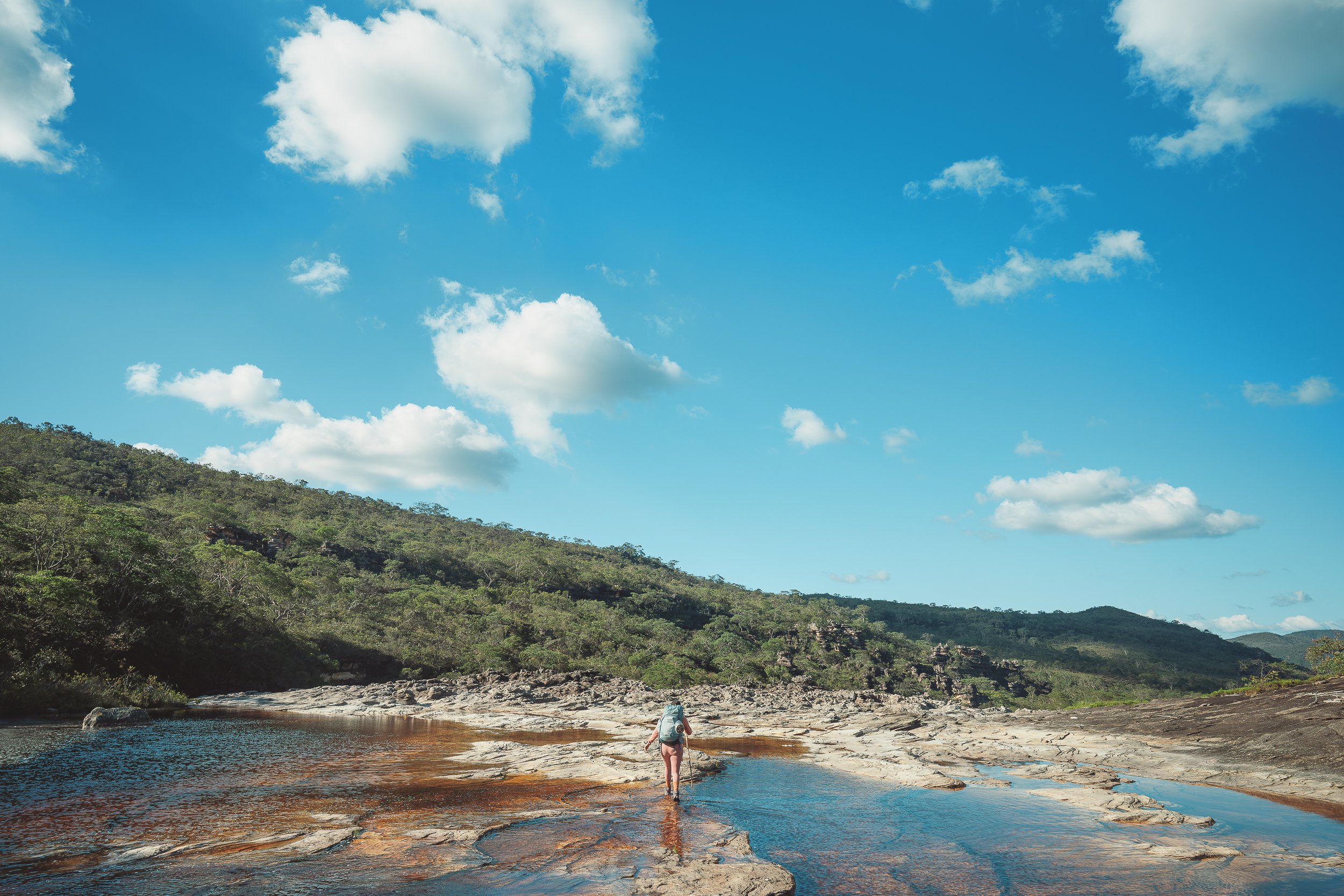
What’s Included
6 Crew Members. 11 accommodations. 34 meals. A trail 3+ years in the making.
-
6 pousadas
2 homestays
1 park lodge
1 wilderness refuge
1 private home
-
11 breakfasts
12 lunches
11 dinners
Daily trail snacks
-
We provide all ground and river transportation within Brazil, from touchdown to takeoff. Includes:
Round-trip transfer between Belo Horizonte and Diamantina
All regional overland transportation
Horses and pack mules (on Day 6)
Two 4×4 support vehicles and one support motorbike
Emergency ground transportation, if needed
-
Six to nine (6 – 9) full-time crew members:
2 Expedition Leaders / Country guides / Translators
1 Regional Guide / Naturalist
3 – 6 Drivers
5 – 10 part-time crew members, including:
Local guides, mule drivers, horsemen, boatmen
Cooks, porters, transfer drivers, and other support personnel
Learn more about the individuals who bring this journey to life.
[Meet the Crew →] -
We provide all critical group gear and essential trail equipment — including tents, sleeping systems, water treatment, and our full camp kitchen setup. We also keep extra packs, poles, headlamps, and other basics on hand, which you're welcome to borrow if you don’t have your own.
That said, if you already have a dialed-in backpack, set of poles, or other gear you love — feel free to bring it. Nothing beats the comfort of something that already fits.
Camping + TrailBackpacks / rucksacks + daypacks
Tents, sleeping bags, sleeping pads
Camp kitchen + tableware
Trekking poles
Headlamps
Water filters and purification systems
Communications + Safety
Two-way radios (crew-use only)
Satellite comms devices (crew-use only)
Emergency beacons (crew-use only)
First-aid supplies (crew-use only)
-
All Documentation & Fees (if any) pertaining to our visits to:
Rio Preto State Park
Biribiri State Park
Itambé State Park
Vesperata (Diamantina)
-
Certified Wilderness First Aid on staff (both Expedition Leaders)
3 full-time support/rescue vehicles
Satellite comms + multiple first-aid kits (trail & vehicle)
Daily communication with local authorities
-
Pre-Expedition Zoom (30 days prior to departure)
Pre-Expedition Group Chat (WhatsApp, launched after application acceptance)
Post-Expedition follow-up (~30 days after your return)
Additional meetings on request
-
Expedition Dossier (itinerary, maps, routes, basic language guide — pre-trip)
GOGO journal + pens (for the WiFi-less nights — on arrival)
Travel plug adapter (on arrival)
Emergency whistle (on arrival)
Memory card of crew photos & videos (post-trip)
GOGO tee shirt (post-trip)
GOGO patch + sticker (post-trip)
The Meaning in the Miles
Savannah & rainforest. Wildfires & miners. Vanishing stories. And a way of life, holding on.
-
The Amazon (rightfully) grabs most of the headlines, but Brazil wouldn’t be the most biologically diverse country on earth were it not for its plethora of other terrestrial ecoregions, including a pair of particularly prolific—and critically endangered—“biomes” found in the Espinhaço: the Cerrado & the Mata Atlântica.
Trailing only the Amazon in terms of size in South America, the Cerrado (Brazilian Savannah) is the richest grasslands on earth, with more than 800 species of birds, 10,400 species of plants, 120 reptiles, 150 amphibians, 1,200 fish, 90,000 insects and 200 mammals, accounting for approximately 5% of the species on earth and nearly a third of Brazil's total biodiversity.
The lush Atlantic Rainforest, meanwhile, harbors more than 1,000 species of birds, 20,000 species of plants, 2,000 vertebrate species, and 300 mammals.
The prolific levels of endemism witnessed in both biomes (particularly with regards to flora in the Cerrado, and trees & fauna in the Mata Atlântica), and the existential threats faced by each, has led to their respective designations as global “hot spots”.
Biogeographically speaking, the Espinhaço is the tale of these two biomes. Due to its relatively high altitude (especially uncommon in the Cerrado), the range represents a unique & fascinating transitionary zone, with markedly elevated levels of endemism. The Cerrado’s campo rupestre ecosystem, for example, located nearly exclusively within the Espinhaço, is thought to be the single most biodiverse ecosystem in Brazil.
You’ll be able to witness the transformation and interplay between biomes & ecosystems throughout our Expedition. It’s a glorious thing to experience.
-
Getting from Point A to Point B has always required a journey in the Serra do Espinhaço. 3 types of trails predominate the backcountry here: remarkable, colonial-era stone pathwaysbuilt by slaves to facilitate the diamond trade along the estrada real; an extensive network of bush trails pioneered by mule-driving tropeiros to facilitate regional commerce; and centuries-old descaminhos blazed by contraband smugglers & later revisited by 18th century naturalists (such as Richard Francis Burton & Augustin Saint-Hilaire) during prolific expeditions across the Cerrado.
-
Don’t expect to read much about it on the interwebs, but the Serra do Espinhaço Meridional (the geomorphological name for the mountainous region surrounding Diamantina) now harbors a remarkable 19 Conservation Units, encompassing approximately 5,000,000 acres of protected area—an area similar in size to the state of New Jersey.
Collectively, the areas are known as the Mosaico do Espinhaço, and feature one of the highest concentrations of species endemism on earth.
We’ll traverse 6 Units during our Expedition, including the State Parks of Biribiri, Rio Preto, and Itambé; the Águas Vertentes State Environmental Protection Area; the Rio Manso Municipal Environmental Protection Areas; and the Várzea do Lajeado e Serra do Raio State Natural Moument.
-
The gypsy woman who convinced an unsuspecting miner to leave his purse of “cursed” diamonds in her capable hands for the evening. The mysterious “captain” who came by river, made an unscrupulous fortune, and spent the rest of his days as a Robin Hood-type backcountry fugitive. The rancher who was hugged to death by a giant anteater near Inhaí. The orphan girl who was raised in a cave near Biribiri.
Welcome to the Serra do Espinhaço, where miners, mule-drivers, and other mestres of the backcountry recount the colorful history of the (not-so-distant) “good ol’ days” to barkeeps, house guests, and any of the rest of us who take interest. We, for one, love to listen.
-
According to the UN, a staggering 89% of Brazilians now reside within urban areas (typically defined as population centers with 2,000+ inhabitants; compared to 56% of people worldwide). Our Expedition will cast a light on life for the forgotten 11%.
We’ll pass through some 18 communities during our trek, overnighting in 11 of them. From UNESCO World Heritage city Diamantina (pop. 50,000), to far-flung Santa Rita (pop. < 10), each & every community on our itinerary has its own compelling character, setting, and reason for being.
Among the communities we’ll visit: the quilombola communities of Capivari, Bica d’Agua, Macacos, and Quarteis do Indaiá; the colonial-era mining settlements of Inhaí, Curralinho, and São Gonçalo do Rio das Pedras; the historic vilas of Biribirí & Santa Bárbara; and the charming agrarian village of Curimataí.
-
UNESCO World Heritage City. Terminus of the fabled Estrada Real. Living testament to Portuguese Baroque & Rococo architecture. Former diamond capital of the world.
Diamantina somehow manages to be all of this & more: the cultural capital of the Espinhaco; a vibrant college town at the crossroads of the past & present; the spiritual, economic, and logistical center of the region.
Even UNESCO couldn’t resist the (truly) inevitable cliché, describing the city as “a colonial village set like a jewel in a necklace of inhospitable rocky mountains.”
And yet, Diamantina (pop. 49,500) remains largely unvisited even by mineiros, known to current generations primarily as a former Carnaval town & provincial backwater.
When people ask us what we like so much about Diamantina, we tell them “It’s a tourist Mecca without tourists.” Which makes it a traveler’s Mecca.
-
Tropeiro. Tutu. Torresmo. Frango com molho pardo. If you’re unfamiliar with the hearty regional cuisine of Minas Gerais, you will be by the end of the trip—and Brazilians everywhere will be jealous.
While the Serra do Espinhaço doesn’t enjoy the same claims to culinary fame as wealthier parts of the state (especially the Campos dos Vertentes region), you can still expect generous portions of savory comfort foods cooked in rustic cast-iron pots over wood-fired stoves.
Treats unique to the region include angu, quitanda, samambaia, carne de sol (ubiqitous throughout the sertão, but less so south of the Espinhaço), frango caipira, and queijo do Serro, a locally-produced semi-cured cheese that’s won international awards & generated a promising amount of culinary hype around the Serro microregion in the process.
-
We’re fond of saying that the difference between arriving in a small community by foot and by vehicle is the difference between arriving in a ghost town & a metropolis.
Exaggeration or not, there’s nothing quite like being received graciously by kind souls in “the middle of nowhere” after a full day (& sometimes night) of trekking through the harsh elements.
Having the opportunity to experience how folks truly live in this part of the world is a privilege few will ever know. Being able to enjoy a home-cooked meal and (where possible) a hot bath is even better.
-
Before diamonds, flowers, and tourism (or the lack thereof), the Serra do Espinhaço was a story about water. And ultimately it is water—not natural beauty—that has protected the region once again.
The birthplace of several of Brazil’s most economically-vital waterways (including the Jequitinhonha, Doce, and San Francisco Rivers), the Espinhaço is bursting with tributaries, creeks, streams, marshes, and peatbogs. Voluminous waterfalls cascade down its escarpments on all sides, creating fertile farmlands to the east, and breathing life into the sertão to the west.
The region can be difficult to explore by foot and even vehicle during the summer months, from December to February, due to the constant presence (or at least threat) of rain and lightning, rapid rivers, and muddy terrain—although this is when the vegetation is at its most verdant, and waterfalls at their fullest.
The daily storms typically taper off by early March, making fall (March - May) one of the most beautiful times of year to explore the region: gushing waterfalls, exuberant vegetation, plentiful springs, and crossable rivers.
Winters (June - August) are extremely mild & dry, making for near-perfect hiking conditions (certain pests aside), although water levels continue to drop (in rivers, waterfalls, etc.) as the year goes on.
The long dry season finally breaks in the Spring (September - November), making September another wonderful month to travel the region: the savannah landscape is parched, dotted by colorful bouquets of flowers & cactus fruit, with gently-flowing waterfalls and easily crossable rivers.
-
The Mosaic (colloquially referred to as simply os Parques, or “the Parks”) represents perhaps the single largest challenge facing the Serra do Espinhaço today.
While most of the its residents are quick to recognize the inherent beauty of the region, and the importance of the waters that flow from it, the persistent creation of conservation units on previously privately-held lands is viewed by many as the overreach of an inept government at best, and the encroachment of an indifferent & destructive force at worst.
The issue at stake is largely economic: the mountains harbor an abundance of rare & precious minerals in one of the historically most-impoverished places in Brazil. The trenches are the tiny impoverished communities located along the outskirts of the Parks who have, within the span of a few short decades, found themselves divided by a proxy-war showdown much larger than themselves.
Some point to tourism as the way forward, with the beauty of the region supplanting diamonds & flowers. Others point to the abject lack of tourism in the region today as a sign of the government’s inability to supplant the resources, and the need for the region to make money now.
With environmentalists & mining industry lobbyists both making fervent pleas to local government officials, the future of the region’s resources remains murky. We’ll hear different perspectives on the Parks throughout our Expedition. Let’s see what conclusion you arrive at.
-
What comes next is anyone’s guess. The new mayor of Diamantina, by all accounts a likable man and one of action, has done well to balance the interests of the mining industry with those of environmentalists. It’s a tight rope to walk, and one that may not be able to walked sustainably. Whether there is an actual vision for Diamantina beyond the present is less certain.
It’s our view that the Espinhaco should begin on the path to becoming the next epicenter of ecotourism & in Brazil (a title currently held by its equally stunning sister region, Chapada Diamantina), with Diamantina as the logical hub, but that seems unlikely to happen in the next decade (if ever). With districts lacking basic civil infrastructure, Parks lacking basic visitor infrastructure, and no visible push to market tourism beyond its historic center (principally, the Vesperata & Carnaval), Diamantina seems content to fade further in the background, even as the global community champions its immediate environs.
The vision necessary to drive that kind of change may simply not be in place yet. Or maybe its just dormant, and this Expedition is about to wake it.
Odds & Ends
Prerequisites
prior trekking and/or outdoor experience is strongly recommended, but not required.
All applicants must undergo a complete physical examination and receive written approval from their physician within 3 months of the Expedition.
Travel Insurance
Proof of adequate medical & emergency travel insurance is required before joining the Expedition. Details are available in our Terms & Conditions. We’re happy to talk you through the details if needed.
What’s Not Included
Airfare
Medical & emergency evacuation insurance (minimum required)
Trip cancellation or other travel insurance
Visas
Any meal or activity not outlined in the itinerary
Alcoholic beverages
Gratuities (tips &/or community donations)
getting there & away
We’re happy to recommend travel arrangements to and from our rendezvous point in Belo Horizonte, Brazil. Please note that Gift of Go does not book international flights on behalf of travelers.
CONNECTIVITY NOTES
3G, 4G & 5G signals (in that order) are widely available across the Espinhaço frontcountry, where we will spend the majority of our evenings & mornings. Those signals are sporadic in the backcountry, however, where we’ll spend the majority of our days. Your connectivity will depend largely on your carrier & plan; if you’d like, we can provide you with a Brazilian SIM card upon your arrival. WiFi is available at many of our accommodations during the mornings & evenings of the Expedition.
Additional Reading
A Flower & A Way of Life in Peril — Scientific American
Life on the rocks in Brazil’s Campo Rupestre — the guardian
Explorations of the highlands of Brazil — Sir richard burton
Brazilian Diamonds: A Historical & Recent Perspective — Gems & Gemology, Spring 2017 Vol. LIII
The Espinhaço Range Biosphere Reserve — UNESCO
Globally important Agricultural Heritage System (GIAHS) Proposal — CODECEX
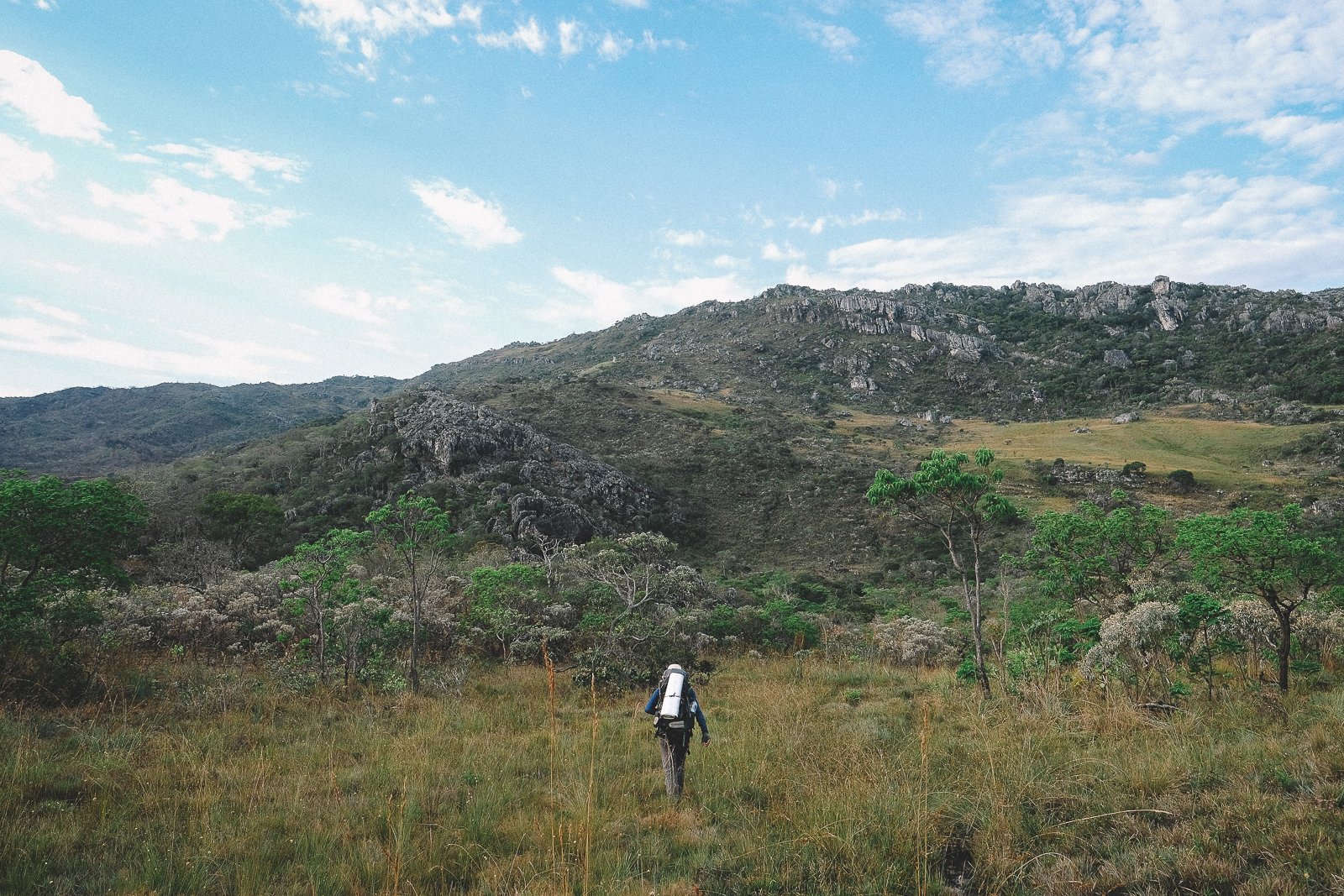
A Walk to Remember
12 days. 203 kilometers. 14,327 meters of gain & loss. One forgotten range.
12 days
203 km of trails & backroads
14,327 m cumulative elevation gain + loss
8 travelers (max)
6+ crew members
14 communities
12+ waterfalls
3 peaks
2 UNESCO sites
6 conservation units
3,000+ species of plants
Few (if any) other folks on the trail
Calendar & Pricing
May 20 - May 31, 2026
$9,995 per person
Includes all crew, lodging, meals, permits, equipment, support vehicles & pack animals
— plus ground transportation.
Ready to take the next step?
[Hold my place.→]
Thinking of coming with 4 or more?
[Let’s talk.→]
Proofs of Life
Photographs from Past Expeditions →
FAQs
Have a question we haven’t answered here? Feel free to reach out or explore our full FAQ page. →
-
We’ve done long stretches of this trek alongside enthusiastic first-timers who did remarkably well — and with seasoned hikers who struggled. So much comes down to mindset, resilience, and how your body responds to day after day (after day) on the move.
That said, this is a serious 203-kilometer trek. You’ll need to be capable of carrying a 10–20 lb (5–10 kg) pack for 10 days, averaging around 22.5 kilometers and 1,433 meters of cumulative elevation gain and loss per day. The terrain is often rugged and sun-exposed — and we’ll be crossing rivers and streams on foot more than once.
For many travelers, the rhythm gets easier as the days go by. Others feel the accumulation. External factors like rain, heat, and trail conditions can be significant — as can internal ones like hydration, sleep, and recovery habits.
If you’re unsure, speak with your physician or trainer before applying. A signed Bill of Good Health is required.
And if you’d like to talk it through with us, we’re happy to help.
[Reach out anytime. →] -
Food is part of the story — and part of the joy.
Over 12 days, we’ll share 34 meals together (and plenty of snacks along the way). Most of those meals will be home-cooked and served in local homes, family-run pousadas, or small-town restaurants. In practical terms, that means hearty, unsophisticated, deeply satisfying comida mineira.
Minas Gerais cuisine is a point of pride across Brazil — known for its traditional techniques (wood-fired stoves, cast-iron cookware) and fresh, locally sourced ingredients. Pork, chicken, mandioca, corn, rice, beans, and seasonal vegetables are staples. Dairy plays an outsized role in the Espinhaço region — with local cheeses winning national and international acclaim.
Breakfasts often include simple cakes and breads, homemade yogurt, quitandas, fruit, and pão de queijo. Lunches and dinners tend to feature stews, handmade starches like angu, and generous portions of locally raised protein — plus rice, beans, and farofa, of course.
At certain points, we’ll visit more varied establishments: refined pousadas, small-town gems, and the occasional brewpub.
We rarely make special requests when dining in homes. Instead, we invite our hosts to prepare what they love to eat. For many, cooking for a group of foreigners is both a rare event and a sincere honor — and that spirit shows in the meals.
Past travelers regularly cite the food as a highlight of the trip.If you’ve made it this far, we think you’ll love it.
-
They’re humble. They’re heartfelt. And they’re often a highlight.
We’ll overnight in two unforgettable homes during the trip — each one safe, welcoming, and equipped with beds, bathrooms, kitchens, and protection from the elements.
One is built from modern materials. The other is handmade by its owner from clay, palm leaves, and local wood.
Both have electricity (one was connected in 2024) and hot water showers (one electric, one wood-fired). One has Wi-Fi.
Bathrooms range from simple-but-pleasant to function-first. Beds vary. If you’re used to a dialed-in mattress, this won’t be that — but it’s a real bed, and a welcome one.Neither of our hosts are wealthy. Neither are in poverty. One had never hosted a foreigner before we first came through.
And that’s part of the magic.
Homestays aren’t polished. They’re real. And often times, it’s in those unfiltered, uncurated moments — around the dinner table, during quiet conversation, or shared silence — that something deeper takes root.
It’s the kind of experience that stays with you.
Want to know more about specific homestays? Just ask. → -
Just let us know early — ideally during the Application process — so we can plan accordingly. This is especially important for allergies and intolerances, where advance notice means we can prepare responsibly and thoughtfully.
Most dietary needs can be accommodated on this Expedition, including vegan, vegetarian, lactose- or gluten-free, dairy-free, kosher, keto, low-carb, and diabetic diets. The key is time and communication: we ask for at least 60 days’ notice to build a workable plan around your needs and the realities of the terrain.
Let’s figure it out together — so that when the time comes, you can focus on the experience, not the ingredients.
-
Most mornings and evenings, you’ll have some signal. Most afternoons, you won’t.
We’ll spend most nights in small towns or homestays where 3G and 4G are generally available. 5G exists in a few places, but we wouldn’t count on it — and coverage varies by provider. If you’d like a local SIM card on arrival, we’re happy to help.
Wi-Fi is available at most accommodations — usually in the mornings and evenings. Our crew carries satellite communication gear in case of emergencies.
-
Nine (or ten, depending on whether you opt to ride horseback on Day 6) days of trekking across rocky trails and rough dirt roads can take a toll — even on the heartiest of hikers.
That’s why we travel with three full-time support vehicles — two 4x4s and a trail-ready motorbike. All stay in contact with the crew by radio — and by satellite, if needed — and follow parallel routes that allow us to respond quickly if support is required.
If you’re tired or dealing with a non-serious injury, you’ll have the option to continue the journey by vehicle, following a route that keeps you close to the group. On days when pack animals are available (like Day 6), riding is also an option for short stretches.
If a serious issue arises, we’ll transport you to the nearest appropriate medical facility.
Note: Travel insurance is required for all travelers. -
Nearly everything. This Expedition is designed to be as all-inclusive as possible.
Included:
Full-time and part-time Crew
Lodging (homestays, pousadas, refuges, etc.)
All meals, snacks, and non-alcoholic beverages
Ground transportation throughout the Expedition (including transfers to/from BH)
Pack animals, permits, entrance fees
Trail gear: packs, poles, headlamps, water treatment systems (you’re welcome to bring your own)
Expedition dossier, pre-trip meeting, and GOGO merch
Not included:
International and domestic airfare
Travel insurance (required)
Personal clothing and gear (boots, rain layers, etc.)
Alcoholic beverages
Tips, souvenirs, or other discretionary spending
For a detailed breakdown, see the Inclusions section above — or [contact us with questions →]
-
We’ll walk through exactly what you’ll need (and what we’ll provide) during your pre-trip meetings. Once your application is confirmed, you’ll receive a detailed packing list — including field-tested favorites from our Expedition Leaders.
We provide nearly all non-personal gear, including packs, trekking poles, camp kitchen equipment, water purification systems, and more. You’re welcome to use your own if you’d prefer — especially if you have a favorite pack, pole setup, or headlamp.
Need help talking through prep or gear? We’re happy to help. [Just let us know →.]
-
Most major expenses — food, lodging, crew, and ground transport — are covered in your trip cost. And most establishments in Brazil accept credit cards.
That said, some cash is always useful for:
Local snacks, cold drinks, or a celebratory caipirinha
Souvenirs or handmade crafts (not tourist shops, but real discoveries)
Tipping (optional, but welcome)
If you’re only traveling with us, $250–$500 USD should be plenty.
If you’re continuing elsewhere in Brazil, plan accordingly.Note: Foreign currency is rarely accepted in the Espinhaço. Exchange cash before you leave home or upon arrival at Confins (Tancredo Neves International Airport).
-
We do not offer shorter Expeditions then 12 days
For private trips of 5+ days, take a look at our [Bespoke Trips →] or feel free to [contact us →].
-
Yes. If you’re interested in joining this Expedition with a larger group — or designing a private version of it —
start here: [Bespoke Trips →] or [contact us →].
-
Unless otherwise agreed upon, the rendezvous point for this Expedition is Tancredo Neves International Airport (CNF) in Confins, Minas Gerais, Brazil. We’ll plan to meet you at your terminal by noon on Day 1.
Your travel details are required as part of your Application — and we’ll ask you to keep us updated with any changes so we can greet you without a hitch.
While we don’t book airfare, we’re happy to recommend trusted travel agents, route options, and accommodations (whether in Confins, Belo Horizonte, or beyond). We’ll also walk through everything during our pre-expedition meetings to make sure you’re set up for a smooth arrival.
If you have questions in the meantime, [just reach out →].
-
Tips are never expected, but always appreciated — and entirely up to you.
If you’d like to leave a tip at the end of the Expedition, we ask that you give it to one of our Expedition Leaders, who will distribute it fairly among the full-time and part-time Crew Members. If there’s someone you’d like to recognize personally — or a community you’d like to support — we’re happy to help deliver your contribution after the trip.
You’re also welcome to tip someone directly during your journey (a host, a cook, etc.), though many travelers find it simpler to pass everything through the Crew at the end. Either way, we’ll make sure your thanks reach the right hands.
-
By and large, Brazilians enjoy partaking in a good drink or two — as does our Crew.
During the evenings of our Expedition, ice-cold beer and locally made cachaça are usually available either on-site or nearby (in town, for example). Even on backcountry nights, don’t be surprised if a bottle makes an appearance around the fire.
Our only real rule: wait until we’ve reached our destination for the day, and enjoy in a way that doesn’t interfere with the experience — yours or anyone else’s.
At the end of the day — literally and figuratively — a good drink can bring good people even closer. Just know that if it ever becomes a problem, we’re obligated to intervene, per Section 12 of our Terms & Conditions.
-
All of our trips are booked on a first-come, first-served basis.
With a maximum of 8 travelers per Expedition — and only a handful of departures per year — spots can fill quickly. We recommend booking as early as you feel comfortable, especially if your dates are fixed or your schedule is tight.
If you’d like to talk through timing or availability, [reach out. →]
“here and there, between the stern peaks, lie patches of snow-white sand or a narrow bit of green plain, confused and orderless, a fibre in the core of rockmountain. The land… is illiterate, and it is wild.”
- Sir Richard Burton (1869)


